
ndege AIRKENYA, AEROLINK UGANDA & REGIONAL AIR INFLIGHT MAGAZINE NEWS MARCH - MAY 2024 FREE COPY www.airkenya.com www.regionaltanzania.com www.aerolinkuganda.com BOOK ONLINE
The Greatest Waterfall of the Nile
A New Experience in an Old Location Walking the Serengeti in the Company of Kings
Murchison:
Tambarare:
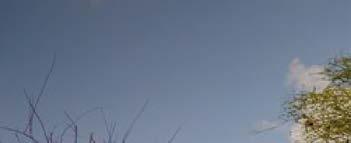

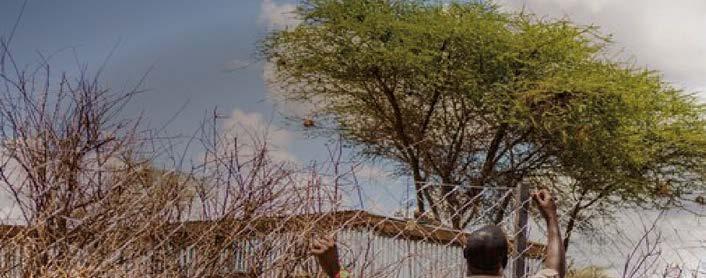



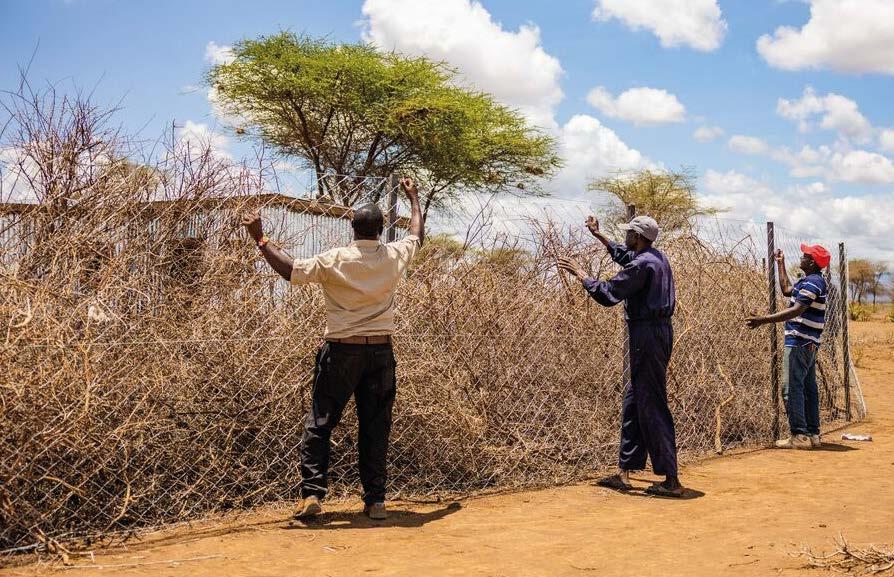


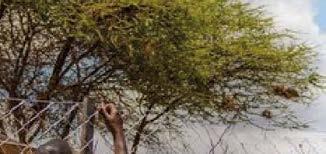




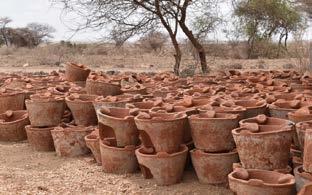
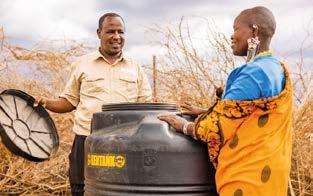
Could you or your company sponsor one complete predator-proof boma with smar t elements? Your gift of Ksh300,000 (£1,500) today would help Maasai communities live alongside lions without conflict.

2 | NDEGE NEWS |MARCH - MAY 2024
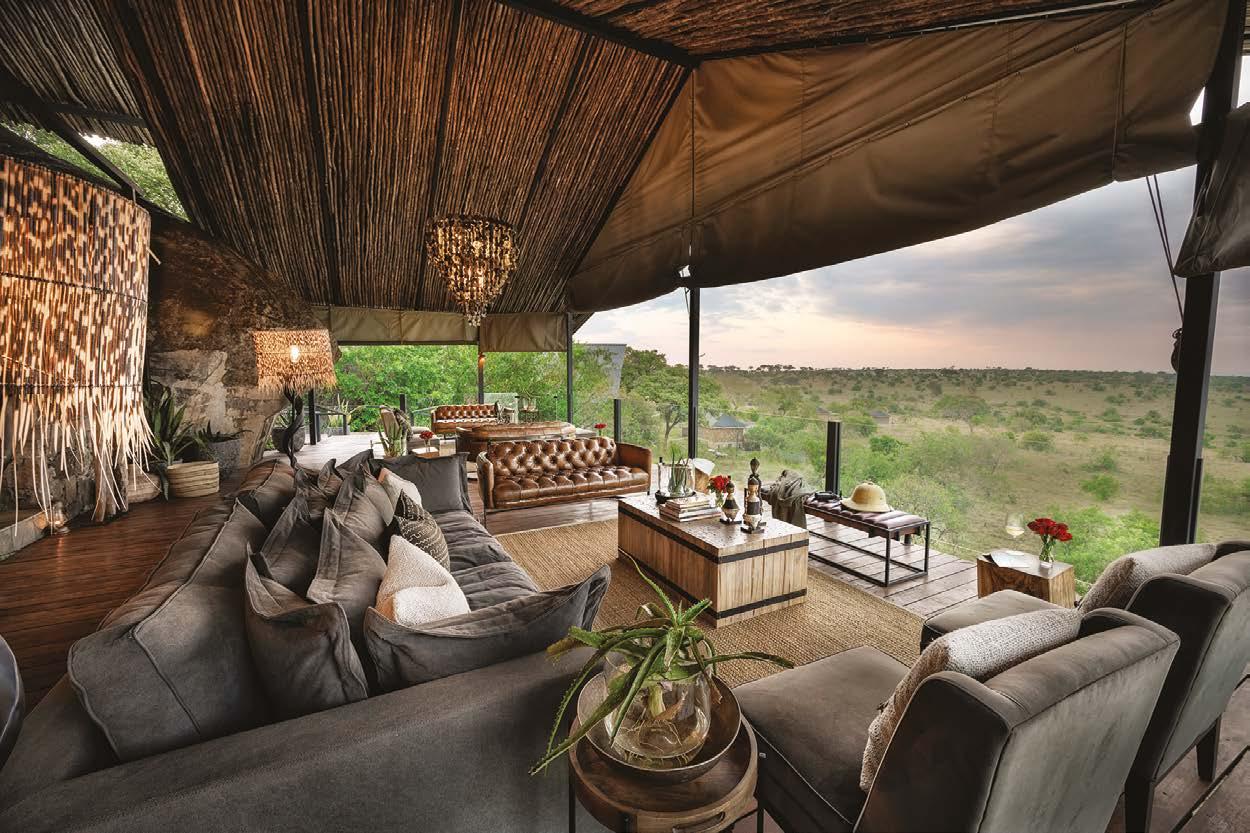

L o c a t e d i n s o m e o f t h e m o s t i c o n i c d e s t i n a t i o n s o n T a n z a n i a ' s l e g e n d a r y n o r t h e r n s a f a r i c i r c u i t , o u r t h r e e l o d g e s e m b o d y e v e r y t h i n g t h a t ' s s p e c i a l a b o u t t h i s r e g i o n o f E a s t A f r i c a E a c h m a k e s t h e m o s t o f t h e v a s t l a n d s c a p e s , b r e a t h t a k i n g s c e n e r y , a n d p r i s t i n e w i l d e r n e s s a r e a s t h a t s u r r o u n d t h e m , f i l l e d w i t h c h a r i s m a t i c w i l d l i f e s p e c i e s A n d e a c h s h a r e s a n o v e r a r c h i n g e t h o s o f r e s p e c t f o r p e o p l e a n d p l a n e t .



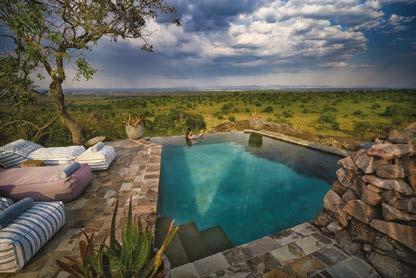

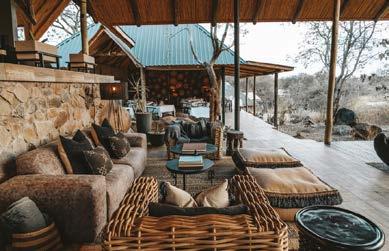
W W W N I M A L I A F R I C A C O M
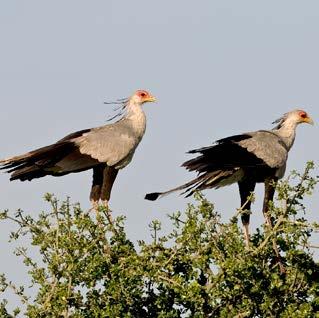
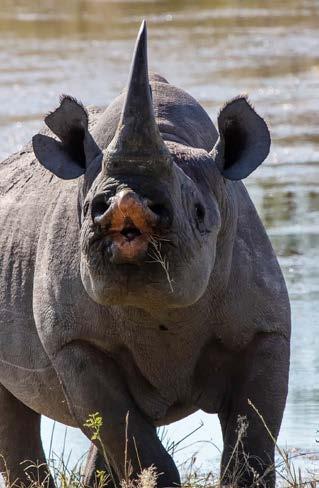

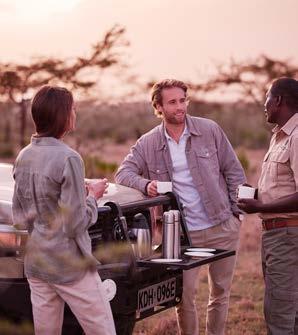
FEATURES
22 A United Force for Conservation and Adventure: Welcome to Saruni Basecamp
24 Saving Uganda’s Endangered Pangolins, One at a Time
28 Murchison: The Greatest Waterfall of the Nile
32 Tambarare: A New Experience in an Old Location
36 Ephantus: One Man on a Conservation Mission
38 Walking the Serengeti in the Company of Kings

4 | NDEGE NEWS |MARCH - MAY 2024 inside MARCH - MAY 2024 39 33 34 14 REGULAR 05 Welcome Note 06 Editor's Note 07 Cover My Story 08 Airkenya News Update 12 Regional and Aerolink News Update 14 - 21 News Update
29
Welcome on board
Dear Ndege News readers,
Get ready for an exhilarating ride because 2024 is shaping up to be a phenomenal year for AirKenya and its sister companies. We are charting a course toward an exciting horizon, where enhancing our operations and broadening our regional presence are at the heart of our mission. Fasten your seatbelts as we take your travel experiences to new heights!
Good news first! AirKenya recently took delivery of an additional Dash 8-202. This aircraft not only increases our fleet size to 9 aircraft but also symbolizes our relentless drive for excellence. Known for its stellar reliability, efficiency, and adaptability, the Dash 8-202 is perfectly suited to meet and exceed our operational requirements during the busy periods of the year. Its arrival promises to revolutionize our service offering, adding layers of flexibility and dependability to both our scheduled flights and charter services.
The benefits of this additional 37-seater pressurized aircraft will extend to Tanzania, where we plan to use the group's synergies to assist Regional Air Services to meet the increasing demand for charter services. This collaboration between the two sister airlines is a testament to our unified vision for growth and excellence across the region.
The good news does not stop there. We have added an extra Caravan to AeroLink Uganda in response to increasing demand for air travel to the country's spectacular national parks. Whether you are going trekking with the Gorillas in Bwindi, taking a river cruise to the bottom of Murchison Falls, or just appreciating the breath-taking scenery and

large concentration of wildlife at Kidepo Valley National Park, you can count on us to get you there with seamless comfortable flights.
At the core of all these exciting developments is our unshakeable commitment to quality and safety. We have invested in the latest technologies, maintaining our aircraft with the utmost care, and providing comprehensive training to our flight crew, technical and ground staff. Our aim? To not just meet but exceed the highest standards of safety and service in the aviation industry.
Looking ahead, our strategy is crystal clear – to unite the forces of AirKenya, Regional Air, and AeroLink Uganda, creating an unmatched air travel experience that spans the beautiful expanse of East Africa.
Here's to a year of boundless achievements and shared successes! Thank you for being a part of our journey. Together, we're not just flying – we're making memories.
Aggrey Kangahi Engineering Manager

At the core of all these exciting developments is our unshakeable commitment to quality and safety. We have invested in the latest technologies, maintaining our aircraft with the utmost care, and providing comprehensive training to our flight crew, technical and ground staff.
NDEGE NEWS | MARCH - MAY 2024 | 5
WELCOME NOTE
Karibu
Dear Fellow Adventure Seekers,
Perhaps this flight is a short hop to an exciting event: A wedding, a birthday celebration, even a destination you won as a raffle prize. Perhaps it is a first time flight or a longer journey to a more remote destination. whatever that might be, it is with great pleasure that I welcome you to the latest edition of Ndege News. I'm honoured to continue serving as your editor and thrilled to be your companion on the incredible journeys that span the landscapes of Kenya, Uganda, and Tanzania.

In the previous edition, I shared my enthusiasm for storytelling and my deep affection for the enchanting tapestry of East Africa. Today, I am delighted to report that our commitment to weaving captivating narratives is still going strong. Our region, rich in diversity and splendour, offers an endless array of adventures waiting to be discovered, and I am dedicated to bringing these tales to you.
Ndege News is more than a magazine; it is a vibrant canvas that paints the living, breathing beauty of our destinations. It is a platform that showcases the remarkable cultures and extraordinary people we (and you) encounter. As your editor, my promise is to continue connecting you, our intrepid travellers, with the heart and soul of East Africa.
I once again, wholeheartedly invite you to be an active part of our storytelling adventure. Share with us your own remarkable experiences, your newfound tales, and the moments that left you breathless. In our world, every journey is a story, and every traveller is a storyteller.
Thank you for choosing to explore the skies with us, for making Ndege News an integral part of your travel experience, and for being a cherished contributor to our ever-evolving story. Here's to the countless shared adventures and stories that await us in the vast horizons!
Wishing you safe and unforgettable travels,
Hollie M’gog
 Editor, Ndege News
Editor, Ndege News
Editor
Publisher
The Business Platform Ltd
Hollie M’gog
P O Box 103364-00101, Nairobi.
Tel: 254 -741 070001
Publisher
Email: businessplatformkenya@gmail.com
The Business Platform Ltd
P O Box 103364-00101, Nairobi.
Advertising
Tel: 254 -741 070001
Peter Ondabu
Email: businessplatformkenya@gmail.com
Cell: 0722 770367 ondabupeter@gmail.com
Advertising
Peter Ondabu
Design and Layout
Cell: 0722 770367 ondabupeter@gmail.com
Digital Colour Business Ltd. info@digitalcolourbiz.com
Design and Layout
Digital Colour Business Ltd. info@digitalcolourbiz.com
NDEGE which means aeroplane in Kiswahili is a quarterly Magazine publication of AIRKENYA Express Limited
NDEGE which means aeroplane in Kiswahili is a quarterly Magazine publication of AIRKENYA Express Limited
Wilson Airport
P.O. Box 30357 - 00100 Nairobi, Kenya
Reservations
Wilson Airport
Tel: (254-20) 391 6000
P.O. Box 30357 - 00100 Nairobi, Kenya
Email: resvns@airkenya.com
Reservations
Tel: (254-20) 391 6000
Email: resvns@airkenya.com
The magazine focuses on tourism, hospitality, travel, leisure, conservation and aviation related news in the East African region and beyond.
The magazine focuses on tourism, hospitality, travel, leisure, conservation and aviation related news in the East African region and beyond.
The views expressed in NDEGE NEWS Magazine do not necessarily reflect those of either AIRKENYA EXPRESS, REGIONAL AIR SERVICES and / or AEROLINK UGANDA.
The views expressed in NDEGE NEWS Magazine do not necessarily reflect those of either AIRKENYA EXPRESS, REGIONAL AIR SERVICES and / or AEROLINK UGANDA.
© 2023
All rights reserved. No part of this magazine may be reproduced by any means without permission from the Publisher.
© 2024
All rights reserved. No part of this magazine may be reproduced by any means without permission from the Publisher.
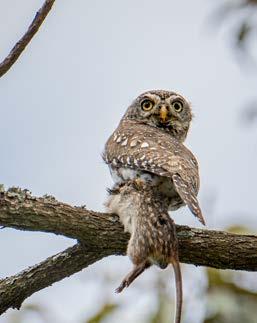
6 | NDEGE NEWS |MARCH - MAY 2024
NOTE
EDITOR’S
Cover My Story
Shiv Kapila
“Everyone knows about owls, not everyone has seen an owl because they are most active at night. But a diurnal Pearl-Spotted Owlet and a Lemniscomys Zebra Mouse (always an interesting record), a rare sighting that might be yours if you look at all the smaller things about you."

In the realm of photography, simplicity wields immense power for me. A single image, if potent and unique, possesses the ability to evoke profound emotions, and at times, even horror. Photography, to me, serves as a means of documenting not only the charismatic big five of Kenya, but also the lesser-known, yet equally spectacular, species that often remain in the shadows.
My journey into the world of photography began during my Master's thesis in 2009. While studying the African Fish Eagle on Lake Naivasha, I adopted a method of resighting ringed birds by capturing them in the act of catching a thrown fish. What started as a practical approach soon transformed into an addiction, pushing me to continuously strive for better and more captivating photos. This passion for photography extended beyond birds to encompass the vast realm of wildlife.

Among the diverse subjects available for exploration, wildlife stands out for its inherent unpredictability. While humans tend to follow familiar patterns, wildlife, especially birds, captivate me with their ability to fly, hunt and showcase breathtaking beauty.
Photography, for me, is intertwined with my experiences during fieldwork expeditions, primarily conducted in southern Kenya. Additionally, an annual journey
to different parts of the country provides opportunities to capture moments of intrigue. Living on a wildlife sanctuary in Naivasha adds an extra dimension, ensuring that my camera is always charged and ready to seize any interesting encounter.
When considering the most photogenic locations in Kenya, the Mara undoubtedly claims a top spot, thanks to its abundance of wildlife and expansive landscapes. A recent exploration of Amboseli, Tsavo West and Tsavo East proved to be a fulfilling experience. However, my fondest memories as a photographer lie in Samburu and Shaba and I eagerly return to those regions whenever I can.
The significance of naming even the smallest subjects in our photos lies in creating awareness and delivering a message. A dung beetle rolling its ball down the road can be more captivating than the conventional attraction of sleeping lions that draw crowds.
I find it essential to emphasise that the best photos often emerge in solitude, where one is assured of capturing unique moments. Moreover, it's crucial to recognise that a remarkable photo may arise from a significant mistake –perseverance and experimentation remain key elements in the pursuit of excellence.
NDEGE NEWS | MARCH - MAY 2024 | 7
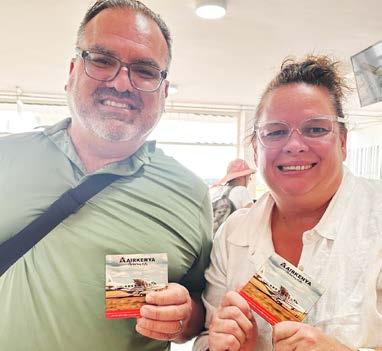
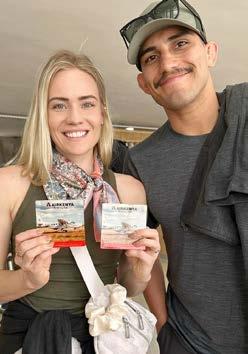
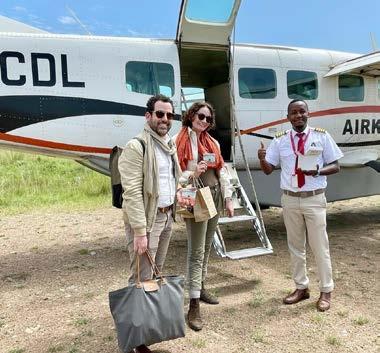
Valentine's Delight: AirKenya's elegant touch with Swiss chocolates and aircraft-themed coasters for our guests
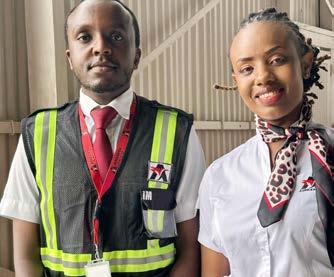
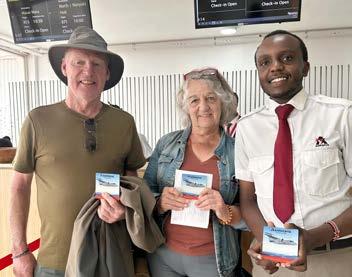
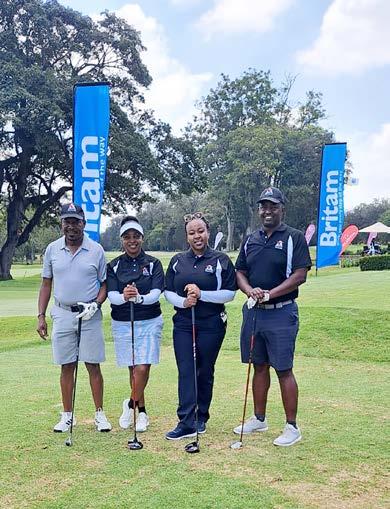
Driving Change on the Green: AirKenya proudly sponsors the KSPCA Annual Golf Tournament and Kenya Education Fund Golf Event. Supporting animals and education through charity, as we swing for a better tomorrow

8 | NDEGE NEWS |MARCH - MAY 2024
AIRKENYA NEWS UPDATE


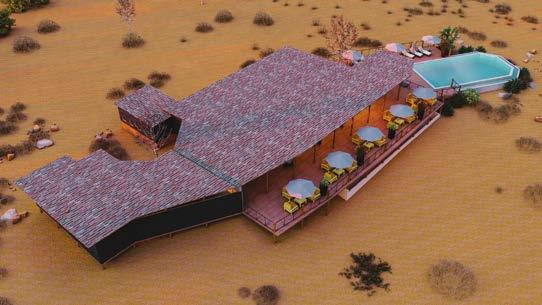
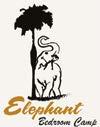




AirKenya's Additional Aircraft
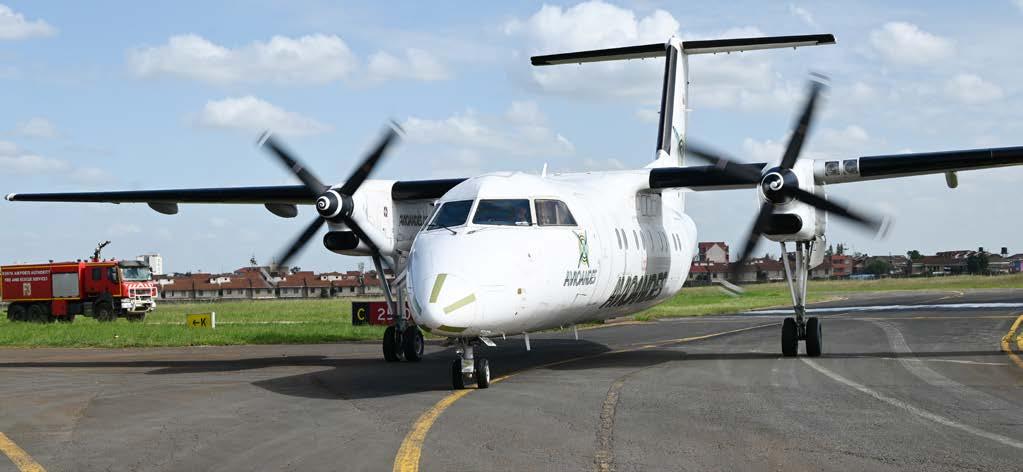
AirKenya is excited to announce the delivery of an additional Dash 8-202 in December 2023. The 37-seater aircraft is undergoing refurbishment to update its livery and interior in line with the AirKenya brand and will be ready for service in time for the busy high season period. This aircraft, renowned for its speed, comfort, and efficiency, will elevate your travel experience, connecting you to your destinations like never before. The quieter fuel-efficient engines portray our continuous commitment to sustainable operations in aviation. This aircraft is AirKenya’s second Dash 8, growing our fleet size to 9 comprising the 2 Dash 8’s, 2 Dash 7’s, 3 Twin Otters and 2 Caravans.
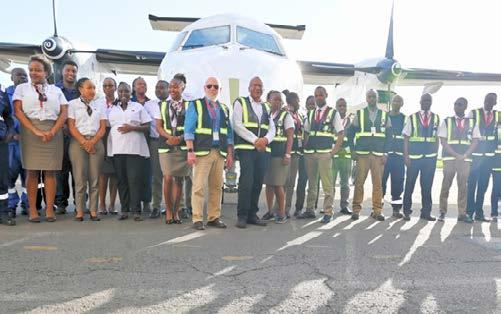

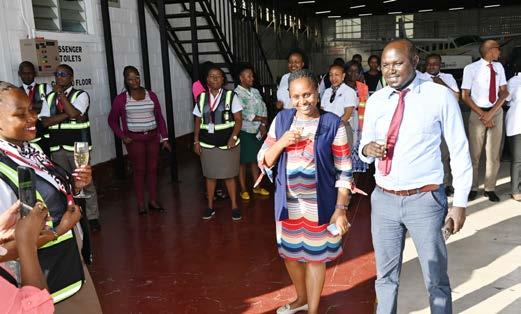
10 | NDEGE NEWS |MARCH - MAY 2024
AIRKENYA NEWS UPDATE
Let’s Connect You with Nature
Nature is the food we eat, the water we drink and the air we breathe. Our lives depend on the goods and services nature provides. A healthy planet means abundant food, clean water, fresh air, healthy people and wildlife.
For over 100 years, Nature Kenya - the East Africa Natural History Society, Africa’s oldest environmental Society, has passionately worked to conserve nature for the wellbeing of people and wildlife.
Nature Kenya is working to save threatened species, conserve important sites and habitats, demonstrate and advocate the values of nature and enhance grassroots capacity and networks for nature conservation.
Our work is firmly rooted in partnership, science and action. We use the best available science to inspire positive action for biodiversity by and for partnersgovernments, local communities and the private sector.
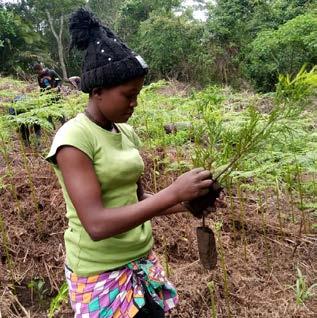

Support our conservation work
Safeguarding nature is a huge task which requires all available support, yours too. Working together offers the best conservation option.
Together, we can do more to save species, restore degraded landscapes, encourage more people to conserve nature, enhance community livelihoods and lobby governments to prioritize conservation issues. You can support us by:
Step onto the green, swing your clubs with purpose, and let your passion for nature take flight! Join us for our Lungs for Kenya Charity Golf Tournament dedicated to restoring degraded forest landscapes in Mount Kenya and the Aberdares. Be part of this great initiative by lending your support.
You can support us by:
• Sponsoring the tournament
• Sponsoring a hole for Ksh. 100,000
• Donating a raffle or auction item
• Donating any amount to help forest restoration
Sponsorship or donations can be made via Lipa na MPesa, Pay Bill>business number 100300>account Golf 2024 or by cheque payable to Nature Kenya.
For more information kindly call 0739200216 or email Angela nkmembership@naturekenya.org


NDEGE NEWS | MARCH - MAY 2024 | 11
Forest restoration in Hombe.
a
a DONATION
LEGACY
our EVENTS
Becoming
MEMBER Making
Leaving a
Sponsoring
ADVERTORIAL
Regional Air gifts passengers a surprise Valentines package with exclusive branded key rings
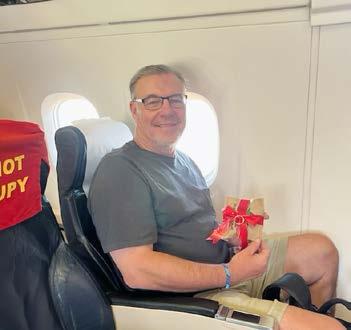
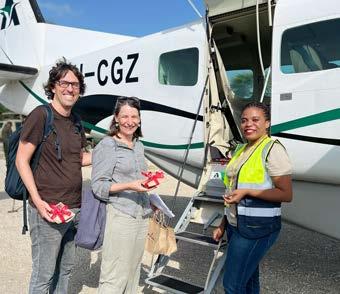
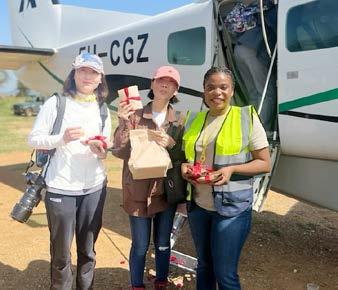
Love Takes Flight at AeroLink! Roses greeted passengers, igniting love before takeoff
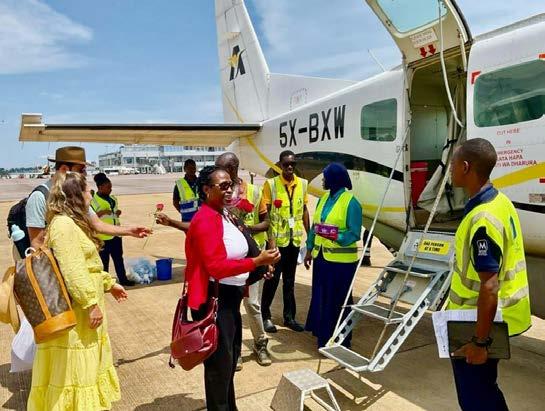


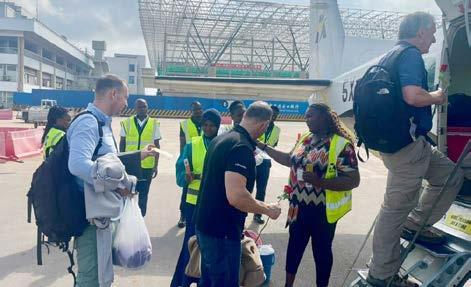
12 | NDEGE NEWS |MARCH - MAY 2024 REGIONAL AIR / AEROLINK NEWS UPDATE
Across the Skies with Words

Across
[2] The bird that graces our front cover this issue
[5] The endearing term given to a baby pangolin who rides on his motherʼs back
[8] Large reptiles that can be found in profusion at the base of Murchison Falls in Uganda
[11] A place where one can walk with kings courtesy of Lemala
[12] Which species has a hook-lipped and square-lipped variety
[13] The Kiswahili word for bird and the name of our inflight magazine
Down
[
1] The genus of a sausage tree
[3] A forest species of shaggy monkey that is black-and-white
[4] A snake that is slow-moving and sun-loving
[6] A rat that applies a deadly poison to itʼs fur
[7] The term given to a dark morph of any animal (or bird) that over-produces melanin
[9] The Laikipia ranch where the very last of the Northern White rhino can be found. As well as chimpanzees rescued from the illegal pet trade
[10] A long-legged bird that appears to have a quill behind its ear

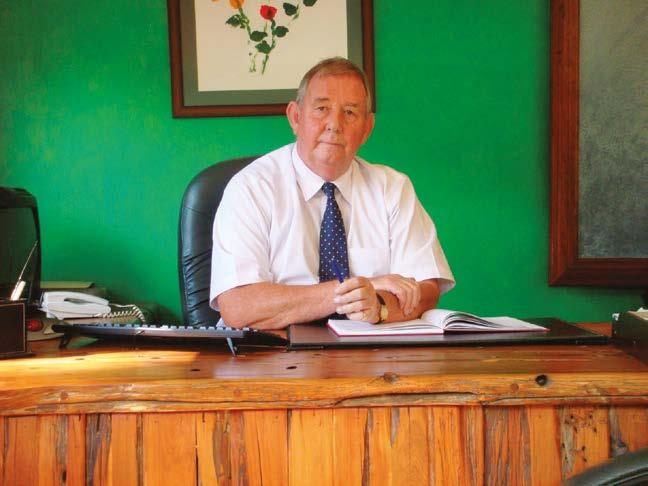
Looking to buy a car? Sean Garstin Motors www.seangarstinmotors.com Tel: 0715 002 323 Co nsul t t h e pr o f e ssi o nal s wi t h your ne w and p r e- o wned r e qui r em e n t s Impor te rs of quali t y used v e hicl e s from Japan the UK and Thailand James Gichuru Road, Lavington, Email: sean@seangarstinmotors.com Sean Cell +254 722 513 143 Josphat Cell +254 722 301 494 Simon Cell +254 722 725 580 1 2 3 4 5 6 7 8 9 10 11 12 13
KWS Marks World Monkey Day at Oloolua Forest, Ngong
World Monkey Day, celebrated annually on December 14th, honours our primate relatives and raises awareness about their conservation. The Kenya Wildlife Service, WWF-Kenya, NEMA, Nature Kenya and National Museums of Kenya gathered for a tree planting day at Oloolua Forest, Ngong. This day recognizes the incredible diversity of monkey species and the importance of preserving their natural habitats. World Monkey Day advocates often emphasise the need for responsible pet ownership, protection against illegal wildlife trade and support for organisations working towards primate welfare. It's an opportunity to appreciate these intelligent and playful creatures while promoting global efforts to ensure their survival. From the smallest marmosets to the majestic apes, World Monkey Day encourages education and actions to safeguard these vital members of our planet's biodiversity.
KWS declares it’s commitment to ensuring that primate species recovery strategies are formulated to champion effective primate conservation and management, to curb the current threat to 50% of Kenya’s primate biodiversity. This includes supporting and championing the retro-fitting of power poles in coastal regions where primate electrocution (especially colobus) is high.

Declining Birds of Prey Population Could Harm Public Health

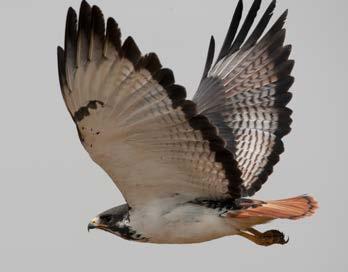
Did you know that thirty vultures can clean a zebra carcass in less than two hours … that means flies have no time to lay eggs or spread disease! It means that stray dog populations do not grow out of control due to access to extra food from carcasses that have not been attended to by birds of prey or other wild carnivore species.
Birds of prey soaring the skies are signs of a healthy ecosystem. Kenya’s skies are rapidly losing their soaring predators and carcass-cleanup-crews, the vultures. This is simply down to electrocution, poisoning and habitat loss, especially forest clearance, in that order. Losing a critical number of individuals means that populations can take over 10 safe years to recover. Some of Kenya’s most iconic raptors, including the Secretary Bird, the Augur Buzzard and many more species are now critically endangered, the the Lammergeier vulture may be down to less than 10 roaming individuals across the whole country! Birds of prey play crucial roles in the ecosystem including prey regulation, carrion eradication, disease (tuberculosis, rabies, and anthrax) and rodent control – they are, therefore, invaluable to the ecosystem and human health. The growing network of raptor-unfriendly electricity grids in Kenya, poses a significant risk to raptors and populations of other large birds. It is estimated that hundreds of millions of birds die every year from collision and electrocution with power transmission lines across the continent – but there are options, raptor-safe power poles exist! We just need to mandate their implementation and retro-fit existing poles, starting in protected areas. There is no doubt that humans will be affected if we continue to disrupt the ecosystem with unsafe power poles and the use of poison.
14 | NDEGE NEWS |MARCH - MAY 2024
NEWS UPDATES
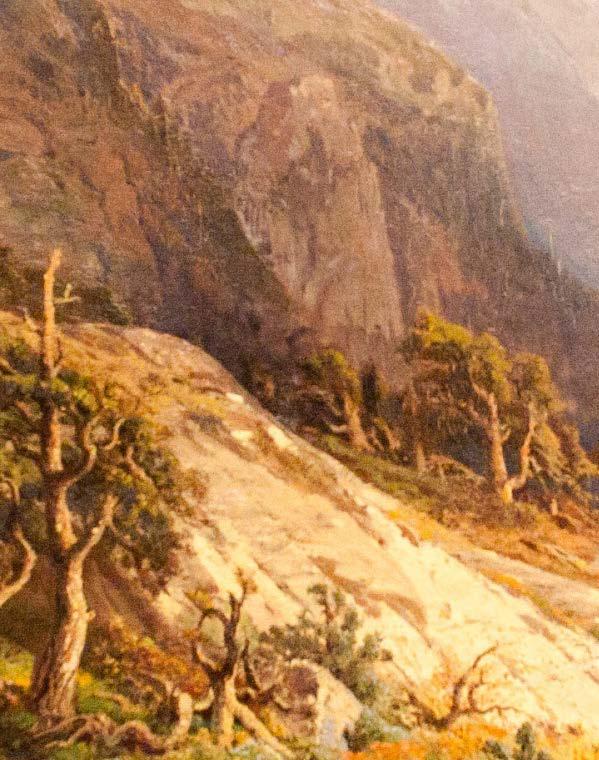
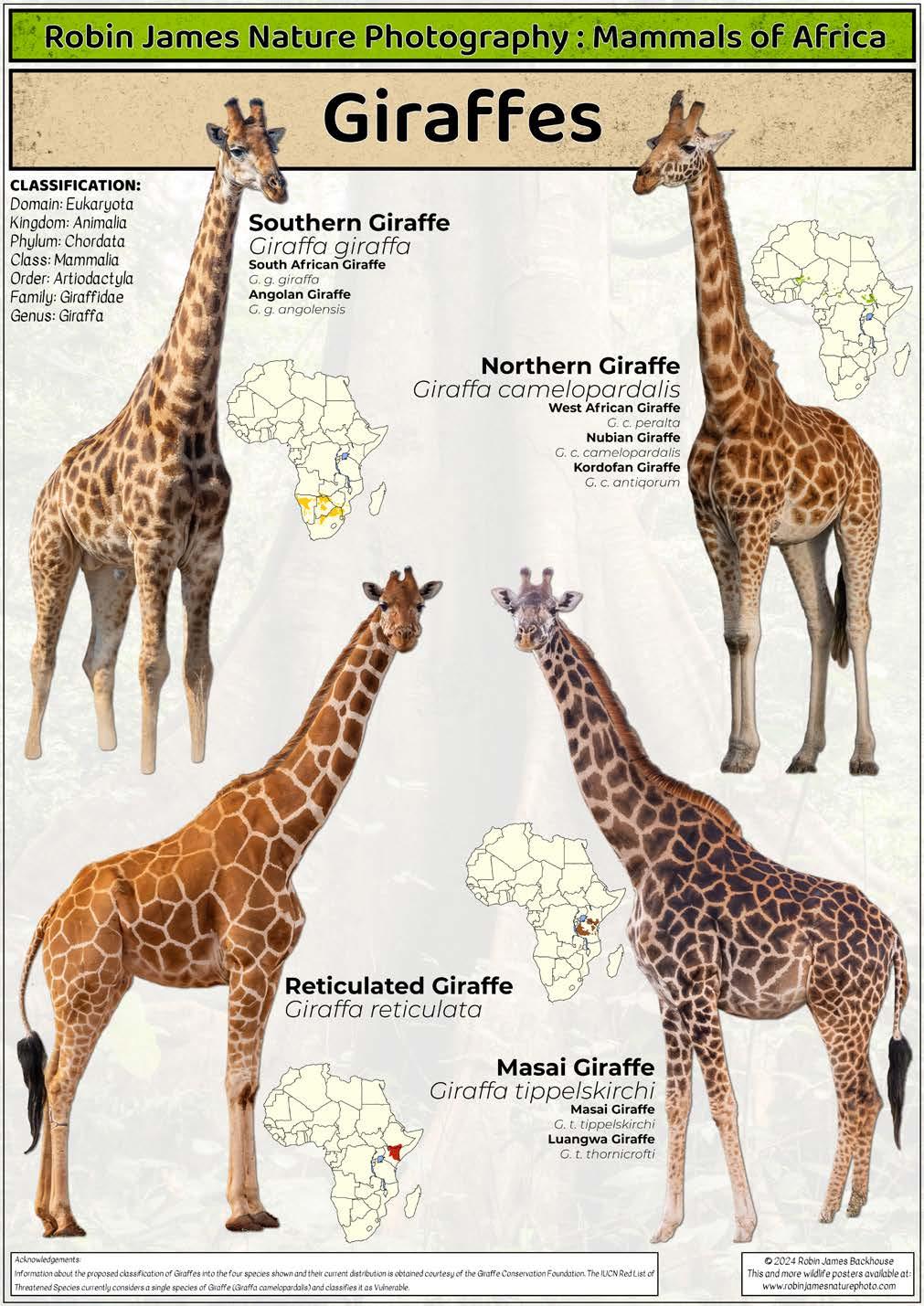
Translocation of Black Rhinos to Loisaba Conservancy
Rampant poaching in the 70’s and 80’s drove black rhinos almost to extinction. From nearly 300 remaining back then, Kenya now has nearly 2,000, and in many conservancies, the carrying capacity is being strained. So, the search for new pastures has resulted in Loisaba becoming the 17th black rhino homeland. With the help of KWS specialised veterinarians, 11 females and 10 males made the move. Considerable work was invested in choosing Loisaba as an appropriate environment for a new rhino population. The preparation for the arrival of the rhinos spanned several years and involved various assessments - ecological, disease risk, security, operations and fence surveys, each accompanied by an environmental impact assessment. Specialised infrastructure and rhino rangers needed to be trained and taught how to use tracking equipment … a mammoth feat that deserves huge recognition. Kenya now hosts the third-largest rhino population in Africa, after South Africa and Namibia.
The project was supported by the San Diego Zoo Wildlife Alliance, The Nature Conservancy, The Elewana Collection and Space for Giants. In total 21 rhinos were translocated from Nairobi National Park, Ol Pejeta Conservancy and Lewa Wildlife Conservancy to Loisaba Conservancy.
German Embassy Donates Two Vehicles to KWS
The German Embassy in Kenya recently provided support to the Kenya Wildlife Service by donating two heavy-duty vehicles and assorted office equipment. The handover ceremony was conducted by the German Ambassador to Kenya, H.E. Sebastian Groth, along with other embassy officials. Kenya's rich biodiversity is a source of national pride. The received donations will contribute significantly to wilderness management.


Fighting Wildlife Crime with Multilateral Cooperation Between African States
The United Nations Office on Drugs and Crime together with the URA, hosted a SAMA workshop in February 2024 in Entebbe, Uganda. The workshop provided a platform for the member states to share best practices that they can emulate from each other in order to combat illicit wildlife trade across the continent. UNODC hopes to strengthen the capacity of the wildlife law enforcement community to prevent, investigate, prosecute and adjudicate crimes against protected species of wild fauna and flora. Intelligence shared, increases the number of seizures and helps dismantle more illicit wildlife trade networks not only across the continent but globally.

16 | NDEGE NEWS |MARCH - MAY 2024
NEWS UPDATES


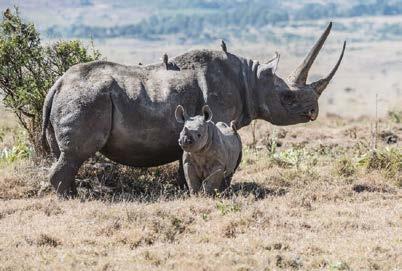
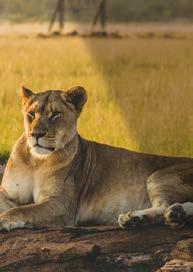
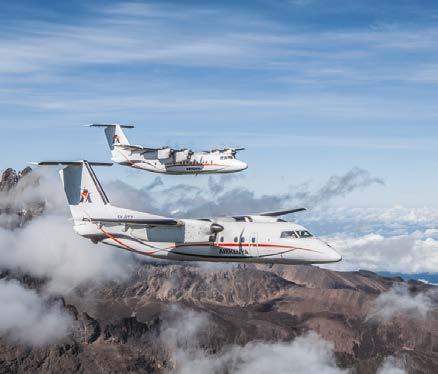


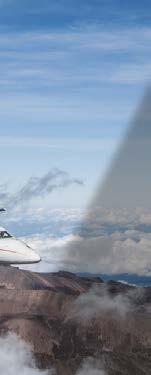


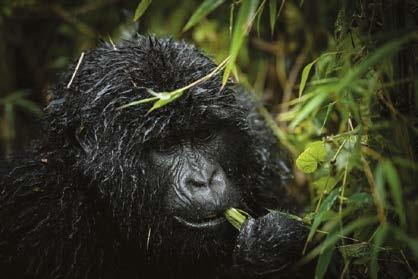

NDEGE NEWS | MARCH - MAY 2024 | 17
BLOSSOMS & BEYOND
The Sausage Tree
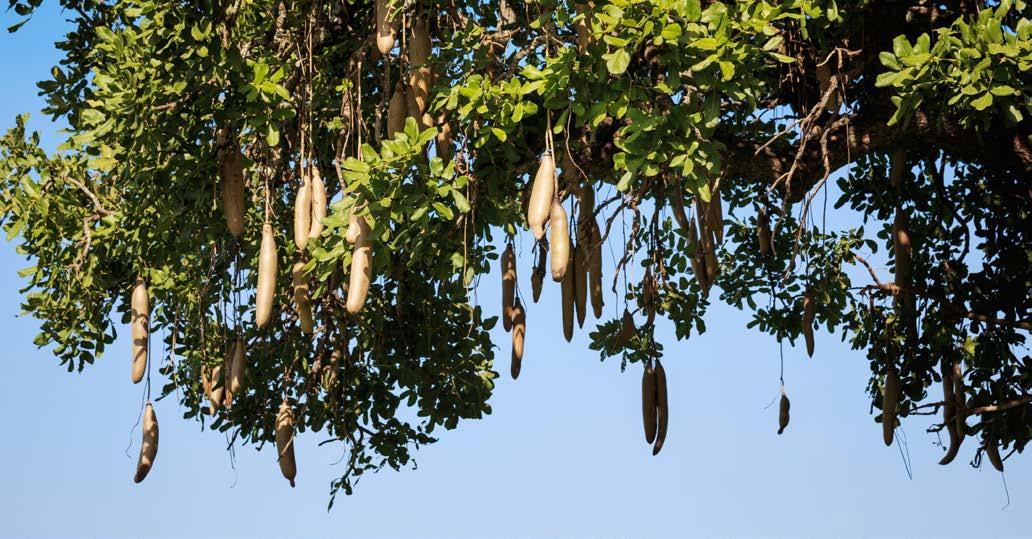
Kigelia africana
It would very much hurt to be hit on the head by a sausage from a sausage tree! These 2-10kg ‘sausages’ are incredibly difficult to break into and so often only elephant and the rodent-teeth of porcupines are able to open them up. Baboons, bush-pigs, some hippos and monkeys would love to get inside!
Almost every ethnic group in Africa that lives alongside these trees has their own version of an alcoholic brew made from the dried fruits. This brew can be a core component in some cultural events. The fibrous insides of the fruits are also used as loofahs for a bathtime scrub. Leopards love to lounge in their spacious branches, perfect ambush stations on the impala that come to browse on the fallen maroon flowers. Flowers that emit a scent only at night as they are mainly pollinated by bats, although carpenter bees do visit them throughout the day.
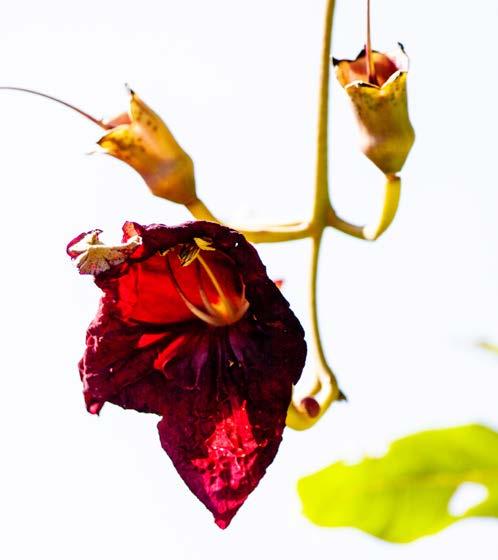
18 | NDEGE NEWS |MARCH - MAY 2024
NEWS UPDATES
THE BIRDS & THE BEES
Coracias caudatus
These birds are named for their unique ability to perform aerial acrobatics in flight. This consists of side-to-side rolling motions and fast, shallow dives from high elevations. There are 12 species of these fierce predators whose harsh calls do not match their beautifully coloured feathers. The male and female cannot be told apart and both are carnivorous, hunting a variety of small prey, including ground-dwelling insects, millipedes, centipedes, spiders, scorpions, snails, lizards, rodents and even small birds.
Lilac-Breasted Roller
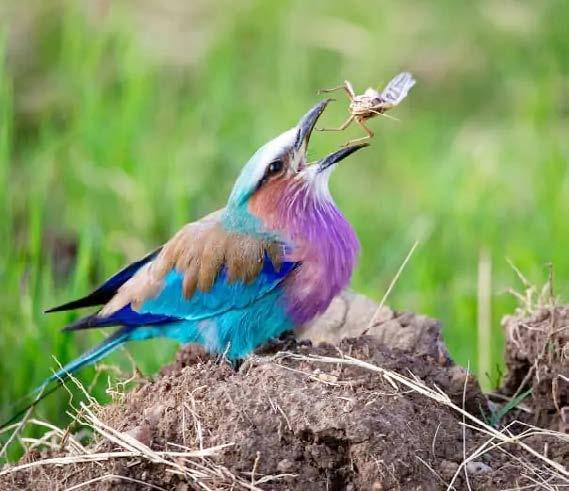

NDEGE NEWS | MARCH - MAY 2024 | 19 NEWS UPDATES
TRUE!
I HEARD IT ON SAFARI!
Black leopards exist! Many species, especially cats, exhibit melanistic tendencies. This means more melanism is produced making the skin darker, their natural patterns can still be seen though. Leucism is different to albinism in that leucistic animals are still healthy, they are just producing less melanin, their eyes and mouths will be a healthy pink. Albinism is when no pigments are produced – this is a detriment to survival in the tropical wilds as with no pigment you have little protection from the harsh rays of the sun.
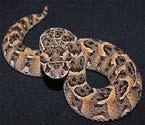
TRUE!
FALSE!
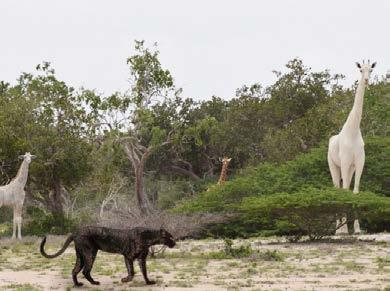
Not all snakes are venomous and snakes are in fact a fantastic reptile to see while on safari … if you are lucky that is! Most sense you coming and will have moved away long before you tread their ground. East Africa has only 13 deadly species and the one you are most likely to come across? The slow-moving, sun-loving puff adder.
PHOTO: Fact Zoo
Ostriches do eat grit, small stones and pebbles and these can account for up to 20% of their dietary intake. These stay in the gizzard and are tumbled together with digestive juice to help with digestion. As they are broken down, they pass through the digestive tract and more are eaten. Ostriches are omnivores, eating about 1.5kg of food a day, from roots to flowers, bulbs, grasses, grains and fruits. They also eat insects, lizards and small rodents. In their natural habitats water is not always readily available, and ostriches are known to be able to survive for two weeks or more without drinking. Instead, they gain most of the moisture they need from their food. PHOTO: Africa Freak
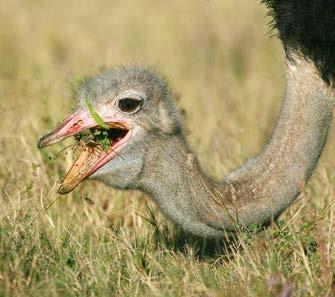
Male weaver birds weave nests of all shapes and sizes. It’s a fiddly job and sometimes the fussy female doesn’t think her new home is up to the task of raising chicks and so she unpicks the hold to the tree branch and the nest falls forlornly on the ground, or into the water. No matter, the male begins to noisily weave again! And no … not all weavers are solely black and yellow.
PHOTO: Warwick Tarboton

FALSE!
FALSE!

Porcupines (from old French meaning spine hog or thorn pig) do not shoot their quills! Porcupine quills are a very good form of defence against predators that may opportunistically prey upon porcupines. Nobody consistently preys on these spiky rodents as the consequences are really quite prickly. The porcupines raise the usually flat lying quills using skin muscles and will back into potential predators, or even just inquisitive but threatening beings, so quickly that it may feel or even look as though a quill or two was fired. The quills are in fact stiff, hollow hairs with microscopic, backward-facing barbs at the tip.
PHOTO: Quora
20 | NDEGE NEWS |MARCH - MAY 2024
IT MUST BE TRUE
NEWS UPDATES
PHOTO: Melanistic Leopard and leucistic giraffes are two images merged, the giraffes were in Garissa (The Hirola Conservation Program) and the leopard is the famous Giza from Laikipia (Barend Lamprecht).
SMALL & SPECIAL
Lophiomys imhausi
Mammalwatching: Bats, Rats & other Random Mammals
By Jon Hall and Charles Foley
Welcome to the wild side of East Africa, where the spotlight isn't just on the Big 5, but on the 395+ lesser-known, extraordinary mammals that make this region a haven for wildlife enthusiasts. Forget birdwatching – have you ever tried mammalwatching? Picture this: safari adventures where you're not chasing after lions and elephants but carefully monitoring bushes for rare rodents, spelunking into caves in pursuit of bats and embarking on game drives to spot creatures most people have never even heard of.
Enter the intriguing world of the Crested (or maned) Rat, a flamboyant character with a fashion sense that would make a Skunk jealous. Its multi-coloured fur, adorned with black, brown and white hues, comes complete with a show-stopping crest along its spine – like a Skunk that decided to leave the barber mid-shave.
This slow-moving rodent has a unique defence mechanism: a deadly poison obtained by chewing the bark of the Arrow Poison tree (Acokanthera schimperi) and applying it to its fur. It's a walking toxin, with enough poison to (potentially) take down an elephant. When disturbed, the Crested Rat isn't afraid to show off its side-fur as a warning signal to potential predators.
But the mystery doesn't end there. Scientists are still figuring out how these creatures avoid poisoning themselves. There's also speculation that they might
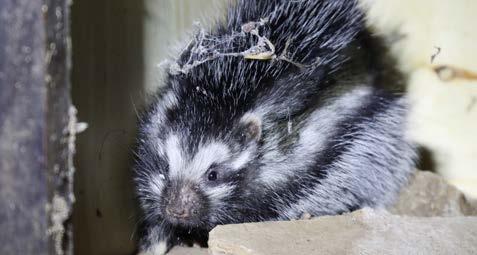
Maned (Crested) Rat


be the oddballs of the rodent world, practicing monogamy and raising their young as a pair –a rarity in the mammal kingdom.
For years, the Crested Rat remained elusive, a mythical creature on every mammalwatcher's wish list. That was until whispers led Jon Hall to Nanyuki, Kenya, an hour’s flight from Nairobi with AirKenya. Armed with a torch, an unusual request and down by Burguret River, Jon asked the star of all lesser-known mammals and primates, Joseph to lead the way! Lo and behold, at 3 am, Jon’s light fell upon a Crested Rat, nonchalantly waddling off into the forest – a moment etched into the annals of Jon’s year.
So, if you find yourself at a hotel in the Aberdares or around Mt Kenya, don't forget to inquire about these elusive mammals. You could be one of the privileged few to catch a glimpse of the Crested Rat, about which little is known, making your visit to East Africa a wild, unique and unforgettable experience.
Happy mammalwatching, Jon Hall & Charles Foley
Jon Hall began mammalwatching in 1991 when he lived in Zambia. In 2005 he set up www.mammalwatching.com, the world’s largest mammalwatching community. He lives in New York.
Charles Foley is a senior conservation scientist at the Lincoln Park Zoo in Chicago. He has worked in wildlife conservation in Tanzania for over 30 years and is an avid mammalwatcher. More about watching maned rats and other mammals visit mammalwatching.com
NDEGE NEWS | MARCH - MAY 2024 | 21 NEWS UPDATES
Joseph, the Maned-Rat guide
PHOTO: Jon Hall
PHOTO: Ben Chapple
A United Force for Conservation and Adventure: Welcome to Saruni Basecamp
In the heart of Kenya, a powerful alliance has emerged, weaving together the legacies of two pioneering safari companies into a tapestry of sustainable tourism and unwavering conservation. This is the story of Saruni Basecamp, born from the union of Basecamp Explorer Kenya and Saruni Lodges and Camps. From the onset, Basecamp and Saruni embarked on their separate journeys with a singular vision: to create extraordinary safari experiences while nurturing the communities and landscapes that sustain them. This dedication to community-based conservation has served as their reference point, leading them to champion responsible tourism and empower local communities in the Masai Mara and Samburu.
What began as a collection of rustic tents has blossomed into a thriving
force of sustainability. Today, Saruni Basecamp stands as a champion of conservation, with a portfolio of 12 exceptional camps and lodges strategically spread across Kenya's diverse terrains. Guests can choose from a range of small and private accommodations, from the awe-inspiring Saruni Leopard Hill and panoramic Saruni Eagle View to the iconic Saruni Mara, adventurous Saruni Wild, cultural Saruni Samburu, plus the diverse offerings of Basecamp Masai Mara, Basecamp Adventure, Basecamp Mara Houses, Basecamp Wilderness, Basecamp Dorobo Mobile.
Beyond delivering unforgettable safari adventures, Saruni Basecamp actively supports conservation efforts as a member of several conservancies, including Mara Naboisho, Lemek, Mara North, Kalama, and Sera.

These conservancies operate under a collaborative model, forging partnerships with local communities through land lease agreements, employment opportunities, livelihood engagement, and local procurement initiatives. Tourism plays a pivotal role indirectly supporting conservation efforts through the collection of daily 'park' fees – this revenue serves as the primary source for supporting conservation efforts. These funds are utilized not only to sustain the conservancy but they also provide crucial financial support to thousands more members of local communities, fostering economic resilience, in areas such as healthcare and education.
Complementing its renewed brand vision is the unveiling of a vibrant new logo, drawing inspiration from traditional Maasai and Samburu (neck) jewelry. It serves as a visual
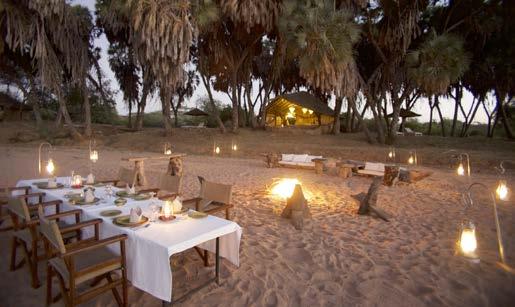

FEATURE
Dinner by the dry river bed at Saruni Rhino
Outdoor living at Saruni Rhino Family Banda
Evening drinks on the tent deck at Basecamp Masai Mara

testament to the inseparable bond between conservation and hospitality, encapsulating Saruni Basecamp's unwavering dedication to safeguarding Kenya's natural treasures while offering transformative experiences to travelers.
Saruni Basecamp is more than just a brand; it's a philosophy deeply rooted in community-based conservation. With a team of over 300 dedicated staff members, 90% of whom hail from local communities, the company actively supports the well-being and empowerment of those who serve as custodians of the land. Saruni Basecamp champions diversity by providing opportunities to marginalized groups, including individuals with disabilities,

indigenous people, and women. The company sponsors training and growth opportunities, ensuring that its positive influence directly benefits the community through empowerment and awareness including providing scholarships in local schools and the Wildlife Tourism College of Masai Mara (the only guiding school in the Mara).
Embark on a journey with Saruni Basecamp where every moment celebrates the symbiotic relationship between conservation, community, and the magic of Africa. More than just a safari, it's an experience that leaves an indelible mark, not only on oneself but on the landscapes and communities that call Kenya home.
 Guided walking safari in Mara Naboisho Conservancy
CLOCKWISE: Sunset from the verandah at Saruni Mara ; Saruni Rhino Swimming Pool
Guided walking safari in Mara Naboisho Conservancy
CLOCKWISE: Sunset from the verandah at Saruni Mara ; Saruni Rhino Swimming Pool
Saving Uganda’s Endangered Pangolins, One at a Time
Part Two of Two (Part One was in our Dec 2023 Edition)
By Anne Calcagno
www.annecalcagno.com

The December 2023 issue of Ndege News highlighted the community-based, non-NGO, work of Moses Arinetwe’s Pangolin Rescue Centre in Rugando (not Rotango as was written in the last article). This Part Two, focuses on “The Pangolin Project: Back to the Wild” endeavours of the NGO Biodiversity Alliance, co-founded by Rebeca Sandoval. The Biodiversity Alliance mission integrates work on wildlife conservation, reforestation and restoration of habitats, community initiatives, and education and advocacy campaigns.
FEATURE
Muzee Pango Rescue ("muzee" means old man or gentleman in Luganda)
PHOTO: Rebeca Sandoval
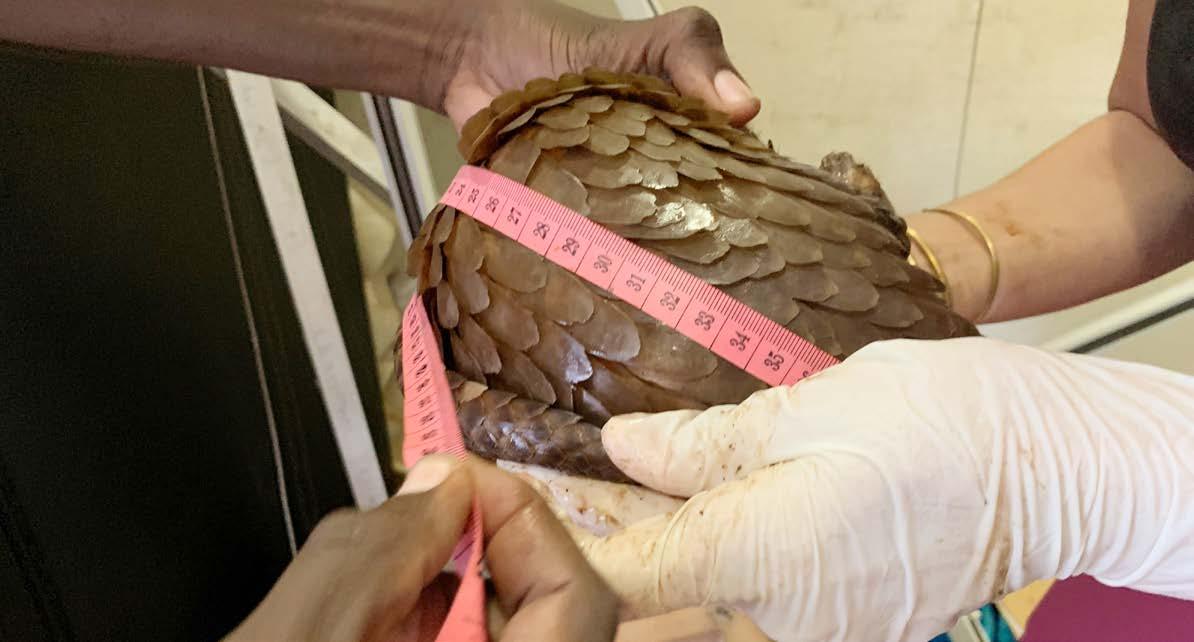
Uganda is home to four of the eight threatened pangolin species: the Ground Pangolin, Giant Pangolin, White Bellied or Tree Climbing Pangolin and the recent Uganda re-introduction, the Black Bellied Pangolin. The global habitat of the eight world pangolin species lies across the tropics. All are now on the IUCN Red List of Threatened Species.
Pangolins, elusive and nocturnal beings with a penchant for solitary living and burrow-dwelling, are rarely seen in the wild. Surprisingly, these creatures have maintained a form similar to their current one, for an impressive 56 million years. Concerted conservation efforts over decades have allowed us astonishing, close-hand encounters with habituated gorilla, chimpanzee and golden monkey family troops. Lions, leopards, elephants, giraffes, Cape buffalo, hippos, they all attract the safari goers to the Pearl of Africa, but it is high time that we give pangolins, "the least known, most illegally trafficked mammal, in the world," their deserved protection.
WildAid estimates that, worldwide, over 200,000 pangolin a year are poached and killed for their body parts, just as elephant and rhino are. Put another way, Sir David Attenborough, in a BBC Earth special, alerts: “Today, a pangolin will be taken from the wild every five minutes.” Why? Primarily for their scales, used in traditional Asian medicines, the tragic misunderstanding being that their scales are made of keratin, the same protein that forms our hair and fingernails. They have no medicinal value. Two important Ugandan pangolin rescue operations work tirelessly to save these long-tongued species from extinction.
When I speak with Rebeca, her four dogs interject with excited barking, a reminder of the delights and demands of inter-species living. They may not know she’s an accomplished environmental activist with almost 20 years of experience in development, natural resource management and combatting wildlife crime, but they’re certainly enjoying the benefits of sharing her Kampala home base.
From here, she works in close contact with the Uganda Wildlife Authorities to rescue and release trapped pangolin back into the wild, and to close down trafficking supply chains. This past October, Sandoval successfully released two Black Bellied pangolins into Kibale National Park after decades of reported absence across Uganda.
Despite Uganda’s admirable forward–thinking, eco–centric accomplishments in wildlife conservation, the country has not yet been able to shed its unfortunate position as transit hub for illegal wildlife trade. An international issue that reflects transcontinental trafficking in a supply-and-demand pull that sends biodiversity ripple effects across the globe.
Of Spanish descent, Rebeca’s conservation work has taken her all over the world, working with some of the world’s top wildlife conservation and anti-trafficking agencies. She cites Lisa Hywood, founder of the highlyrespected Tikki Hywood Foundation in Zimbabwe, and Israeli, Ofir Drori,
NDEGE NEWS | MARCH - MAY 2024 | 25
Measuring a pangolin. PHOTO: Greg Lavender
founder of the multi-country EAGLE network that has brought over 1,500 arrests, subsequent prosecutions and imprisonments of major wildlife traffickers, as her esteemed mentors. “They taught me early on,” she says, “that if you want to crack down on trafficking, you’ve got to pursue those at the top who control the trail of money.”
Rebeca worked undercover on her first pangolin trafficking case in 2017. “I was at a conference,” she says, “when I received a tip-off. A Chinese national had set up a pangolin breeding farm in concrete enclosures in her back yard in Kampala. I visited her, portraying myself as a person interested in traditional medicines. She took me out for lunch, she chatted volubly, and then I was shown the pangolins in captivity. It was the first time I saw live pangolin. I had to hold back my tears when she handed me a male who was so terrified and shaking, he urinated uncontrollably.” Critical financial support from the Tikki Hywood Foundation enabled UWA to raid and close down the operation and rescue the four
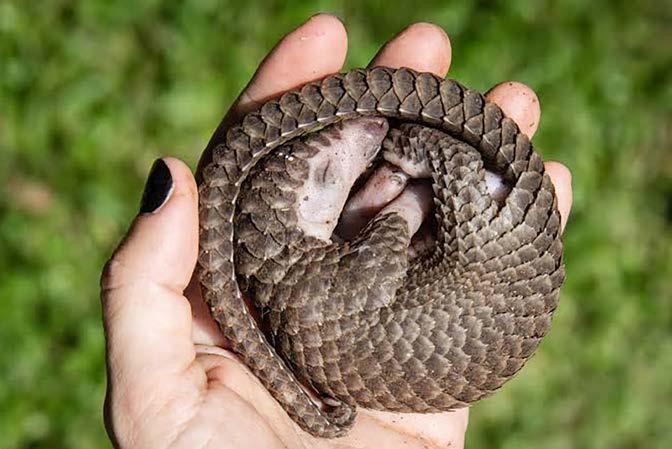
surviving pangolins, including a pregnant female. They were released to safety in Murchison Falls National Park. This arrest can be seen in a compelling short documentary titled “Back to the Wild”, that the THF also funded.
Rebeca and her team, in close
collaboration with UWA, have rescued over 200 pangolins to date. But the disparity between their endangered status and the enormous efforts undertaken to save even one pangolin, is clearly unbalanced. Local farmers are most likely to come upon them unexpectedly. Either they injure or kill them mistaking their long tails for a snake or, misinformed, they
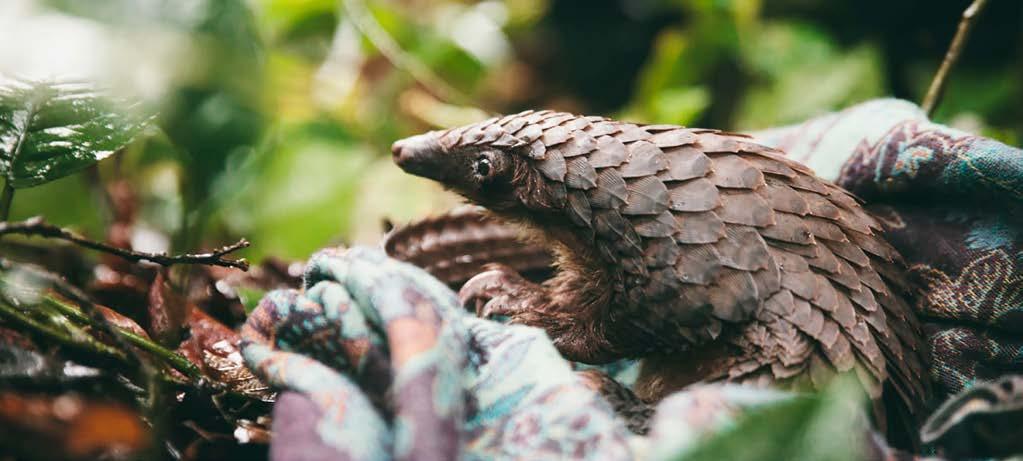
26 | NDEGE NEWS |MARCH - MAY 2024 FEATURE
Did you know? A baby is called a pangopup PHOTO: Isaac Kasamani
Pangolin Release PHOTO: Alejandro Moreno de Carlos
believe they can sell them for a high sum of money.
“In fact, these captures make the low-level offenders very little money,” Rebeca explains “while putting them at great risk for being jailed, which is a terrible blow to their families and communities.” Which is why the Biodiversity Alliance is deeply committed to community education and outreach throughout Uganda. Rebeca says, “I tell people if you see a pangolin, it’s a blessing not a curse. Say no to trafficking them, just as you would say no to drugs.”
Pangolin do not have prolific birth rates, another factor restricting their population. According to Live Science, African female pangolins have about a five-month gestation period, and give birth to one “pangopup". The little one rides on its mother’s tail as she forages, remaining dependent on her milk for up to four months.
Sandoval’s voice is tenderly reverent, as she explains, “They each have a different personality, you know. One can be so sweet, another very mischievous, another silly, playful even. And they instinctively understand when they are in safe hands, and cuddle, relaxing.”
In the wild, pangolins perform miracles for their ecosystems. According to savepangolins.org, their insatiable appetite gives them an important role: pest control. Estimates indicate that one adult pangolin can consume more than 70 million insects annually, ants and

termites being particularly delectable; these they snatch with their long agile tongues and sharp purposeful front claws. The faecal matter they leave behind is excellent fertiliser. Rebeca adds, “We like to call them gardeners of nature.”
But their specialised diet and their highly sensitive dependence on
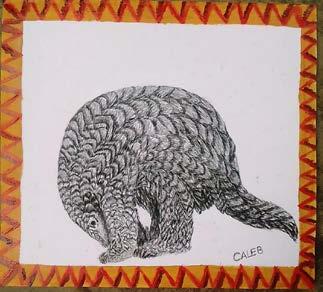
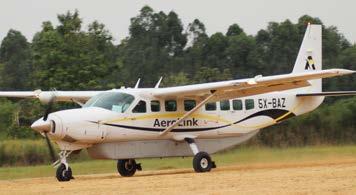
specific natural habitats, makes them extremely difficult to keep in captivity, where they experience a high mortality rate. This is why most NGOs, including Rebeca’s, do not allow public interactions. “We understand tourists’ natural curiosity, but it is not in the pangolin’s best interest to have their releases delayed. We raise money to enable the UWA rangers to have the fuel, crates, and a per diem allowance to reintroduce the pangolin into the wild as quickly as possible.”
The best way we can help is by spreading awareness of and supporting these important Ugandan rescue operations. Uganda’s pangolin heroes work tirelessly, for no personal profit other than the belief that these “gardeners of nature” have the right to exist.
CONTACT INFO:
www.biodiversityalliance.org
biodiversityalliance (Instagram) rebeca@biodiversityalliance.com
NDEGE NEWS | MARCH - MAY 2024 | 27
Pangolin drawn by Caleb aged 15 years
FEATURE
AeroLink Uganda flies to major national parks on schedule and charters across East Africa.
Pangolin rescue. PHOTO: Alejandro Moreno de Carlos

Murchison: The Greatest Waterfall of the Nile
By The Ghost of Sir Samuel White Baker & Hollie M’gog
Borassus palms, floating masses of reeds on luxurious wetlands, and, standing tall, staring intently over swathes of grassland, three Rothschild giraffes! I only mention the giraffe because Sir Samuel did not. When Baker passed this way, ‘deranged by malaria, a weakness in my legs that meant I trembled with each step and a wife in as wretched a state as I, ‘the blind leading the blind’, no giraffes stood tall beneath the palms, no giraffes reached into the leafy Kigelia or sausage tree boughs and no giraffe meat made it into our barely adequate diets.’
Since the early 2000’s the Giraffe Conservation Fund (GCF) and the Uganda Wildlife Association (UWA) have re-introduced Rothschild giraffes to both the Northern and Southern banks of the Nile and the favourable habitat has meant a population increase to over 1,500 individuals now. Two wooden giraffes stared resolutely away from my satisfying breakfast at Twiga Safari Lodge on the Southern Bank and just outside the park boundary – that’s what happens when diets differ so.
It took Sir Samuel three years ‘where we had neither health nor supplies’ to travel up the Nile from Egypt to this point. It took me a hop, a skip and a jump from Nairobi with AirKenya. A ride via the Mara to Entebbe and onwards to Pakuba where I landed
28 | NDEGE NEWS |MARCH - MAY 2024 FEATURE
THIS AND OPPOSITE PAGE:Wild Frontiers boats in search of crocodiles and elephant below the roaring Murchison Falls
PHOTO: Wild Frontiers
on the very similar swathes of grassland that had beheld Sir Samuel when he descended to the shores of Lake Albert, just a little further away. I stayed in a luxurious tent with a light breeze that cooled the sweltering night as reed frogs and hippos dueted from the calm waters. Meanwhile … ‘We were encamped at a small village on the shore of the [Albert] Lake … On the following morning not one of our party could rise from the ground. Thirteen men, the boy Saat, four women, besides my wife and me, were all down with fever. The natives assured us that all strangers suffered in a like manner.’ I disagree Sir Samuel. I rose from my bed with health and supplies of a tasty and wonderfully considerate packed lunch for my trip to the spectacle that had so amazed Sir Samuel and was to amaze me similarly. Murchison: The greatest waterfall of the Nile.
Quite appropriately it was Stanley and his broad smile from Wild Frontiers who captained my boat while for Sir Samuel, ‘eight days were passed at
[the village] before we could obtain boats, which, when they did come, proved to be mere trees neatly hollowed out in the shape of canoes.’ Stanley showed me cliff-nesting bee-eaters, Hemmingway’s crash site, wading elephants and buffalo while I crunched through the sweet flesh of an apple. The trip to the base of the mighty falls took just one meandering hour in which Stanley delighted me with tales and knowledge of legends that would be new even to Sir Samuel. As we drew closer to the roar that still sounded, over a century later, I will let Sir Samuel describe the wonder that was, is and will be, well into the next century, Murchison.
‘As we proceeded the river gradually narrowed to about 180 yards, and when the paddlers ceased working, we could distinctly hear the roar of water. I had heard this on waking in the morning, but at the time I had imagined it to proceed from distant thunder. By 10 o’clock, the current had so increased as we proceeded that it was distinctly perceptible although
weak. The roar of the waterfall was extremely loud, and after sharp pulling for a couple of hours, during which time the stream increased, we arrived at a few deserted fishing huts, at a point where the river made a slight turn.
I never saw such an extraordinary show of crocodiles as were exposed on every sandbank on the sides of the river. They lay like logs of timber close together, and upon one bank we counted 27 of the large size. Every basking place was crowded in a similar manner.
From the time we had fairly entered the river it had been confined by heights somewhat precipitous on each side, rising to about 180 ft. At this point the cliffs were still higher and exceedingly abrupt. From the roar of the water, I was sure that the fall would be in sight if we turned the corner at the bend of the river…. [the boatmen] rowed immediately up the stream, which was now strong against us. Upon rounding the corner, a
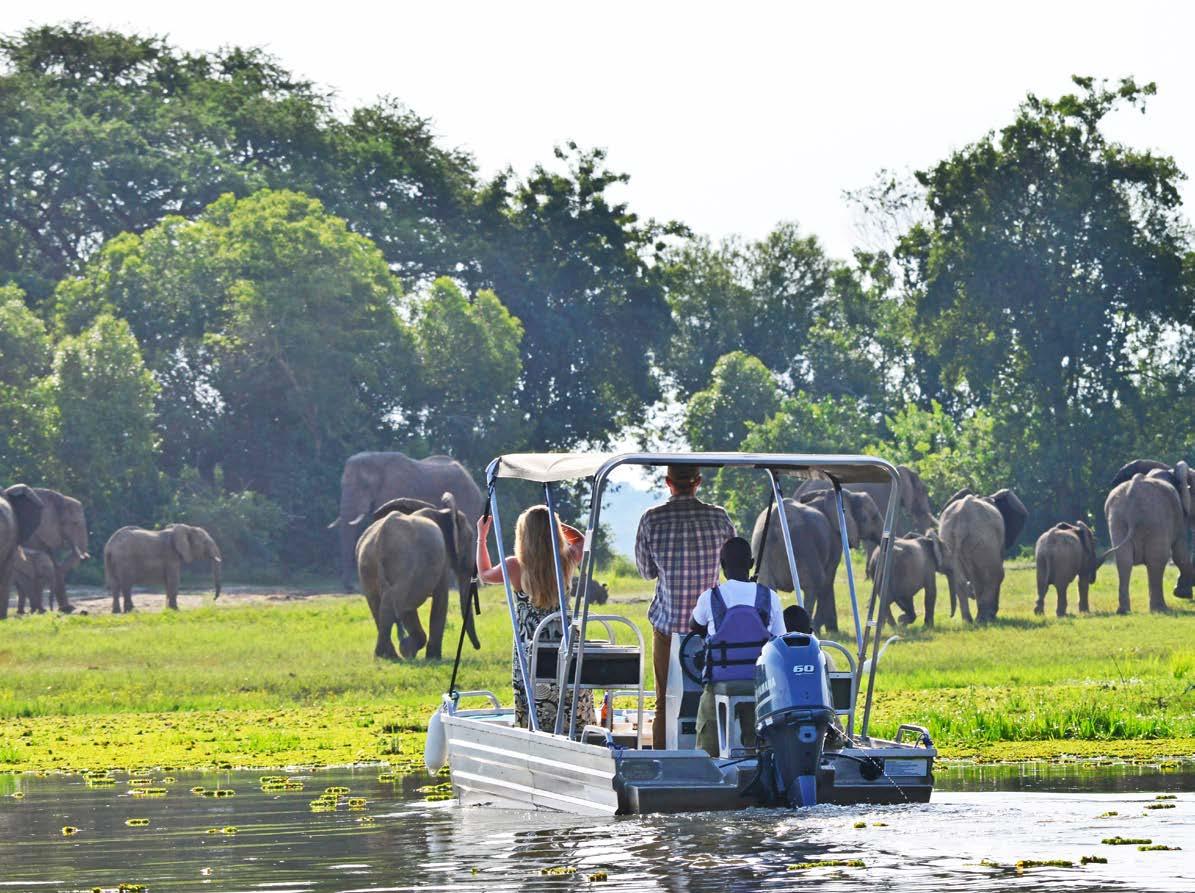
NDEGE NEWS | MARCH - MAY 2024 | 29
FEATURE

magnificent site burst suddenly upon us. On either side [of] the river were beautifully wooded cliffs rising abruptly to a height of 300 ft; rocks were jutting out from the intensely green foliage; and rushing through a gap that cleft the rock exactly before us, the river, contracted from a grand stream, was pent up in a narrow gorge of scarcely fifty yards in width. Roaring furiously through the rock-bound pass, it plunged in one leap of about 120 ft perpendicular into a dark abyss below.’
The fall of water was snow-white, which had a superb effect as it contrasted with the dark cliffs that walled the river, while the graceful
palms of the tropics and wild plantains perfected the beauty of the view. This was the greatest waterfall of the Nile.’
And yet there was more to see. No toiling like Sir Samuel, instead my able captain churned his propellors and wheeled on the current, away from basking crocodiles and downstream towards the Lake that that been Sir Samuel’s goal, a promise to Speke that he would chart the river between Karuma and a body of water that so confused explorers, cartographers and geographers of the era that they scarcely believed the natives tales of its existence.

Sir Samuel paddled up from the southernmost shore of Lake Albert ‘day after day … stopping occasionally at small villages, and being delayed now and then by deserting boatmen.’ Captain Stanley never considered deserting me and my private charter from Wild Frontiers was the epitome of comfort; a shaded canopy, cushioned seats and chair backs and iced sparkling water while Sir Samuel describes ‘the discomforts of this lake voyage were great; in the day we [Florence Baker, his wife] were cramped in our small cabin like two tortoises in one shell, and at night it invariably rained… No acclimatisation can render the European body mosquito-proof; thus we had little rest.’
A sunset cruise, a fishing excursion, a bird (or mammal) watching voyage to The Delta is both unparalleled and not undertaken enough. It is here where one may stumble upon a golden leopard peering at you through leafy boughs, but again it is Sir Samuel who commands a way with words that conjures up a beauty that is simply not escapable … wherever in the world you are from.
‘The [lake] beach was perfectly clean sand, upon which the waves rolled like those of the sea, throwing up
30 | NDEGE NEWS |MARCH - MAY 2024
Wild Frontiers have able captains to pilot all boats

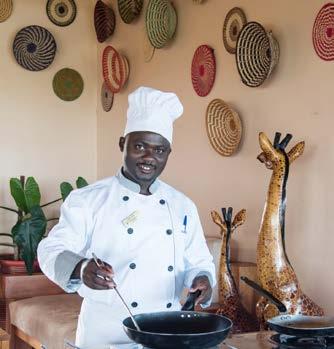
weeds precisely as seaweed maybe seen upon the English Shore. It was a grand sight to look upon this vast reservoir of the mighty Nile and to watch the heavy swell tumbling upon the beach, while far to the south[-west] the eye searched as vainly for a bound as those upon the Atlantic. [This lake] was the key to the great secret that even Julius Caesar yearned to unravel, but in vain. Here was the great basin of the Nile that received every drop of water, even from the passing shower to the roaring mountain torrent that drained from Central Africa towards the North. This was the great Reservoir of the Nile!’
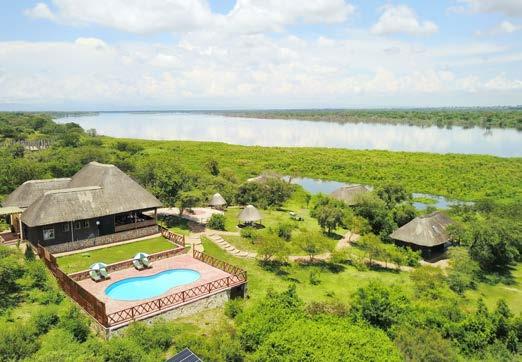
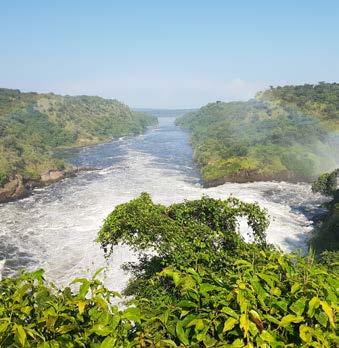
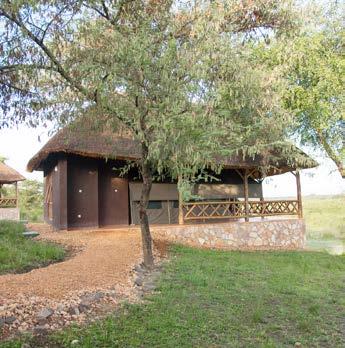

From the South, flowing North and then North-West runs the Victoria Nile, tumbling over Karuma Falls, weaving between the cataracts that chart its course before the cleft in the rocks that is Murchison.
‘The Albert is the grand reservoir, while the Victoria is the Eastern source.’ As the river leaves the lake in the North it is dubbed the Albert Nile (although it is still the White) until it reaches the Mediterranean as just The Nile, with waters that have merged with the Blue at Khartoum.
NDEGE NEWS | MARCH - MAY 2024 | 31
FEATURE
Twiga Safari Lodge is a great place from which to base a visit into Murchison Falls National Park.
Tambarare: A New Experience in an Old Location
El Niño seems to have coincided with my trip to Kenya. It is wet, muddy and my game-drive is somewhat interesting. My guide is focused heavily on the eroded and bumpy road. Suddenly I see four heads sticking up in the high grass to the side of the river-like track.
‘Are those lions?’ I ask the guide somewhat incredulously. He is as
By Sarah Daleke
surprised as I and manages to make a deft and slippery two-point turn to drive up alongside them.
Just as we are meters from them, one of the lionesses starts running straight towards a herd of cows.
Now we too are on the move, ‘I don’t want the lions to kill a cow’ Abdul says as he manoeuvres off-road between tussocks and puddles. It seemed almost farcical that I’d flown all the way from Sweden for a wildlife experience, and yes, I wanted to see a pride of lions on a hunt, but to see them bring down a cow … it didn’t seem quite right, too raw perhaps. My heart beat fast with the excitement and I focused on gripping my seat handles to avoid being thrown from
the open safari vehicle … a lioness can sure run fast!
And then it was all too close for comfort … Abdul turned to cut in front of the charging lioness, to use the vehicle to separate her from the herd, that put me in my open seat right before her. ‘No!’ I heard myself say, ‘not in front of her – she will jump into the car!’
Abdul respected my wishes and, as we drew to a halt, she streaked past joined by two more lions, some distance in front. The herd scattered and one succumbed. A raw wildlife encounter indeed.
‘This is very unusual that lions kill cows here,’ Abdul said as he called the Ol Pejeta rangers to the scene.

FEATURE
Tambarare sundowner
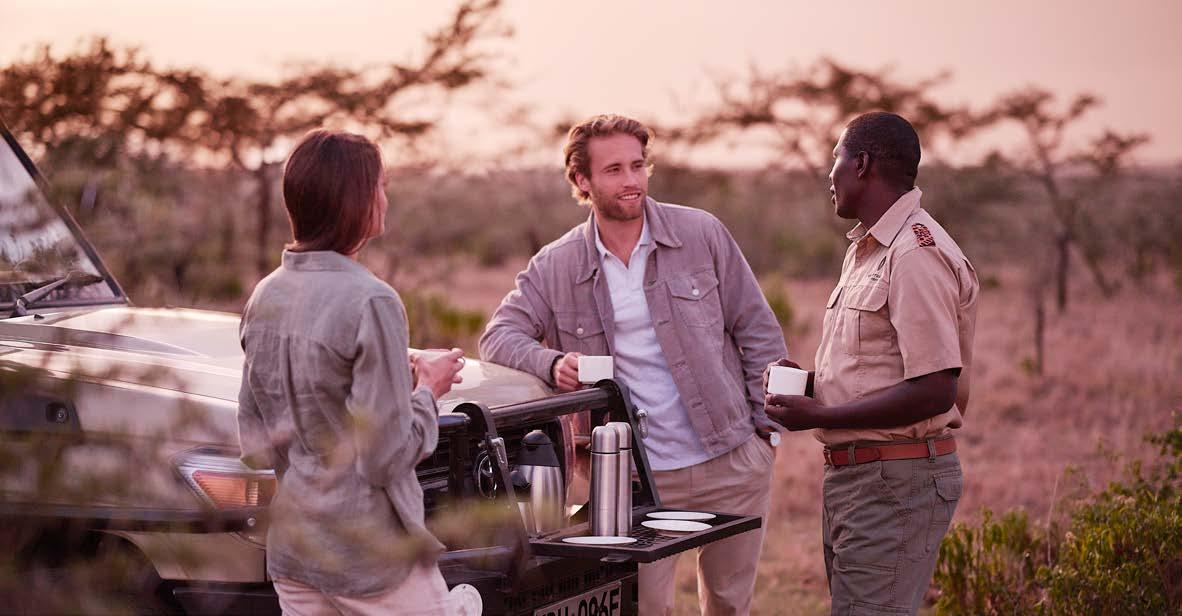
Nanyuki town, just an hour’s flight from Nairobi, is the heart of Kenya’s Laikipia tourism scene. Had it not been grey and overcast, the slopes and snows of Mt. Kenya’s three peaks would have loomed over the airstrip as we landed. Barney’s is a welcoming place for a morning juice or coffee and the gift shop certainly has gifts for all personalities. But it is not long before Abdul Karim arrives to pick me up. He is the head guide at the luxury year-old, Sanctuary Tambarare Lodge which is located in Ol Pejeta Conservancy, a 90,000 acre not-for-profit wildlife conservancy. It only takes us about forty-five minutes from Nanyuki to reach the entrance to Ol Pejeta, the gateway to adventure and the last remaining Northern White Rhinos.
‘Life is about fitness and mating success,’ Abdul tells me as we gaze upon a large herd of grazing impala. ‘At this time of the year, the males fight every morning to see whom gets to mate with the females that day.’ There are Grant’s Gazelles, polka-dotted Guinea-fowl and the world’s heaviest flying bird – the Kori Bustard. 11-19kg!

Having come from the Northern Latitudes and December snows of Sweden, it’s hard to imagine I am on the Equator, flanked by the Aberdare ranges and Mt. Kenya. I pose for a somewhat corny photo – but remember that consciously knowing where and how we are on this Earth is not corny, its special.
The landscape shifts and suddenly we have open savannah on both sides of the road. I take a deep breath and just try to absorb what is around
us. A large herd of buffalos, peacefully grazing together with a big number of zebras, and a group of Southern White Rhinos resting next to them. Cicadas scream at a dizzying pitch as my gaze sweeps across the road where baby warthogs are running around playing, mum keeping a sharp watch. Yes! Like all of us, of course I think of Pumba and the Lion King. A little further ahead we spot a family of jackals, male, female and two pups. Abdul explains that the jackals’ pair for life and live in small family groups.
NDEGE NEWS | MARCH - MAY 2024 | 33
FEATURE
Abdul has been a safari guide for 18 years and is very service minded. He has answers to all my many different questions about the animals and nature, which of course makes the whole adventure even more fun.
As we continue, we see a lonely black rhino on a hill quite close to the road. He has his head up, airing (flehming Abdul tells me!) to see if he detects any female nearby. It is a peaceful and magnificent sighting. He looks like a king surveying his lands. ‘Black rhino are both territorial and more solitary,’ Abdul tells me. ‘They are browsers and the baby will always move before the female. This opposed to the white, who live in herds, graze on the short grass of the plains and whose baby will always follow behind the female.’
Ol Pejeta is the largest black rhino sanctuary in East Africa, over 160 of them! It is also home to the world’s two last remaining Northern White Rhinos, Najin and her daughter Fatu.
The Sanctuary Tambarare lodge is nestled deep in the conservancy. It’s canvas awnings, wooden decks and plump armchairs on colourful carpets showcases sustainable indulgence. I’m met by smiling staff, a warm hand-cloth and a warm, very tasty ginger juice.
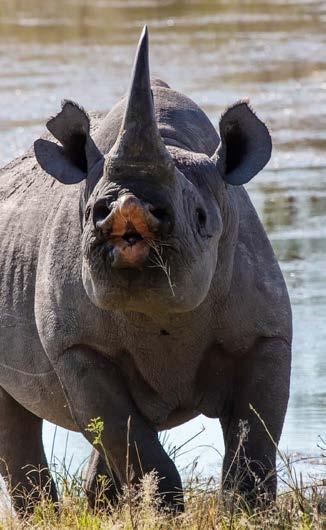
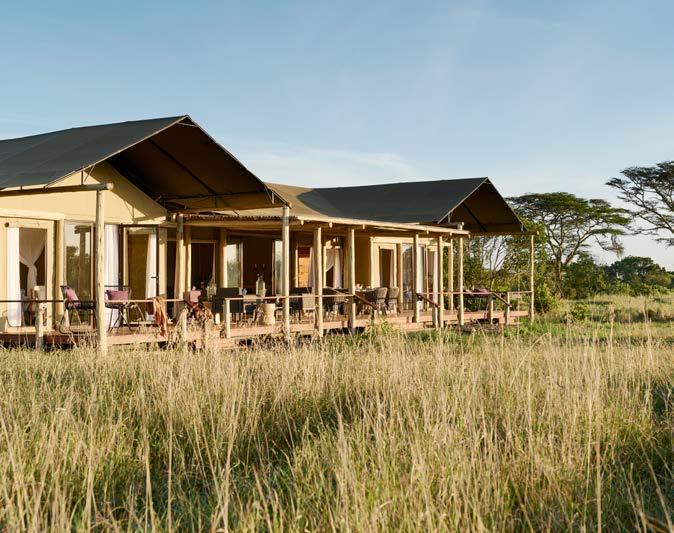
The staff are attentive and personable, I feel comfortable, un-rushed and ready to eat! The menu has all the options; meat, fish and vegetarian. I order and enjoy the beautiful bushveld view as I sit back with a sparkling water and a slice of lemon. The food is delicious and the service high class. The restaurant is located on a verandah-like deck, half of the space is for restaurant visitors while the other is furnished with sofas, loungers and armchairs to rest in, and a multitude of coffee-table books to enjoy.
I am shown to my tent to settle in and rest a little before the afternoon safari. Sanctuary Tambarare is a small lodge, sleeping only 26 guests in ten luxurious guest tents as well as one private two-bedroom villa. The carefully placed tents blend into nature and the whole camp site breathes wildlife and comfort in a thoroughly balanced way. The rooms are spacy, with a huge and very comfortable bed, a luxurious bathroom and a lovely big verandah indulging in the beautiful landscape outside. For those whose fitness must match the sumptuousness of the food and soft-furnishings the rooms all contain a bag with gym and yoga equipment … just in case you’ve no plans to miss your early morning workout!
It is on my afternoon safari that the afore-described lion hunt occurs. But it is not all lions, we meet a lovely herd of muddy elephants. Majesty and power crossing the road before us. Seeing them so close really brings peace to the heart and mind. It is like medicine for your soul. To know that we, beings that consider ourselves so mighty, can know how small and weak we are before such truly magnificent animals.
34 | NDEGE NEWS |MARCH - MAY 2024 FEATURE
The private two-bedroom villa can accommodate 4-6 people and comes with a magnificent view, a private chauffeur, housekeeper, chef and bartender
Dinner finds the deck surrounded by the sounds of the African night, piping reed-frogs, whirring crickets as well as a multitude of unidentified sounds – I would not have minded at all to sit down with Abdul for dinner and continue my line of questioning! This new addition to the Sanctuary Lodges line-up really delivers a luxury experience in everything. From the location to the ambience, the rooms to the food. Their staff are exemplary leaders in service, their guides experienced, professional and personable. My only wish was that I had been able to stay more than one night … oh and that El Niño had not dampened my experience. A few sun-rays always bring a new light to any mud puddle!
And how did Tambarare ensure that I may return? I chose a native tree sapling from their very own nursery and planted it out. I shall be back in time to see how my very own African tree is faring. To see the new friends that I made and to catch some sun.



Factbox:
• Sanctuary Tambarare opened in June 2022
• The Sweetwaters Chimpanzee Sanctuary is also open to visitors
• Horse riding and lion tracking are additional extras
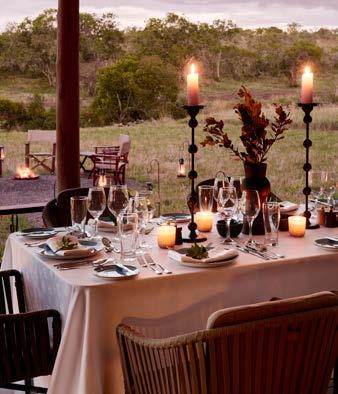


How to get there
AirKenya operates daily flights from Wilson Airport to Nanyuki and its surrounding conservancies.
NDEGE NEWS | MARCH - MAY 2024 | 35 FEATURE
By Sarah Daleke
Ephantus: One Man on a Conservation Mission
“I had no former experience of setting up a centre. I was an educator. So, I started to think, what is relevant for the community? For the students? For the teachers? I wanted to build something I believed in.”
In 2011 Ephantus, a man with a dream and the December 2020 winner of the Disney Conservation Hero Award, took on three empty buildings. Now more than 35,000 learners have passed through the education centre, including students, teachers and other guests. Over 5,000 teachers have participated in the programme, either alongside students or participating in environmental conservation workshops; a multiplier effect indeed!
‘My biggest joy is when I see the students and teachers going back home to their communities and implementing what they have learned here. That work, is what makes the biggest difference, says Ephantus Mugo, Conservation Education Coordinator at Lewa Wildlife Conservancy. ‘I have three main focus areas – wildlife since the wild animals are your neighbours and it is good to know your neighbours. Waste pollution and finally conservation education: Trees, insects, land degradation, more sustainable farming and grazing practices.’
It's quite something to hear Ephantus deliver on his three focus areas –impassioned anecdotes that relate to the everyday lives of these visiting children and their teachers. They see their villages painted on the walls, they interact with exhibits through

sight and sound, touch and smell and absorb messages that relate to what they see and do every day. One exhibit lets the students control rainfall, they then see that rainfall wash off degraded soils on denuded land on one side, land that they pass through each day to school. On the other, they see the benefit of trees and how water infiltration in soil works. ‘This involving of the senses,’ Ephantus says, ‘it allows the students to escape books and learn through seeing. I think we learn more that way.’
But the centre is more than just a walk-through exhibit showroom with giraffe skeletons and a rhino foetus, more than painted walls, snake skins, a stuffed lion, an elephant skull showing off elephant dentition, more
than even a living bee hive, queen and all, more than Ephantus-designed educational posters with fun facts –it’s a journey into an unknown world. ‘We encourage students to stay over with their teachers. We have two big dormitories with bunk beds, mattresses, bathrooms with hot showers and a large kitchen area.’ The mattresses matter. The hot water showers even more.
‘Imagine you have come from a rural area where beds are not a thing. Mattresses even less. Many students sleep on hard mud floors, three or four to a blanket. Can you imagine when they get handed bedsheets and a pillow and asked to make their own bed. For many it is a first! Most have never seen a raincloud burst with warm water right above your
36 | NDEGE NEWS |MARCH - MAY 2024 FEATURE
Ephantus Mugo
head, and on command too … that is what having a hot shower is to them. We then take them outside to see the solar water heater and describe to them how it works – no electricity, just sunshine. Their eyes are wide and often they hold palms to their mouths in astonishment!’
‘Dinner is also an overwhelming experience. Almost all of the students come from food-poor areas and few, especially boys, have ever been involved in cooking. Now they are asked to chop and peel, boil and mash. We explain to them what a balanced diet is and why it matters.’ ‘I make curriculums that teachers can use, they take them away and teach on water management, composting, which trees grow in which soil-type and so on. Students that come from those curriculums, get a chance to practice many of the things they have learned from them.’
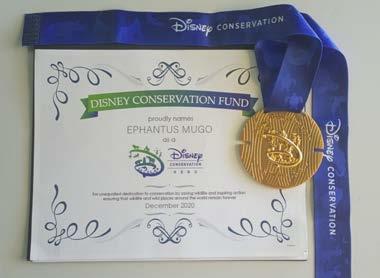
anticipation of the trip-highlight, a visit into the conservancy, is tangible. On this drive, on a bus with all sorts of props, students get to see rhino and elephant, giraffe and lion, antelope and warthogs, all without worrying about crops and proximity – instead they learn to interpret behaviours, to learn the why behind the myths.
over 50 new students enrolling in the program each year. 330 are currently in full scholarship as we speak, with over 800 graduates to date.
And yet there is still more – schools supported with digital booths, computers, dormitories, toilets and the vital employment and training of teachers. Teachers that are from the very communities that need them most.
‘I am proud of the work we do. But of course, it can always be better. I wish to expand the exhibition hall even more. Most of all I wish to find the means to also create an outreach program in order to really be able to follow up and support all the great ideas and projects that students and teachers approach me with. That is what really makes a difference, Ephantus concludes.
And then comes the safari … Dawn finds the students beside themselves with excitement. The
Currently 27 schools in the greater area are included in this education program. 19 primary schools and 8 high schools. Every year the program sponsors the full education of one girl and one boy from each school. That’s
Do you want to help changemakers implement their ideas and transform the environment in their communities? AirKenya does direct flights into Lewa.
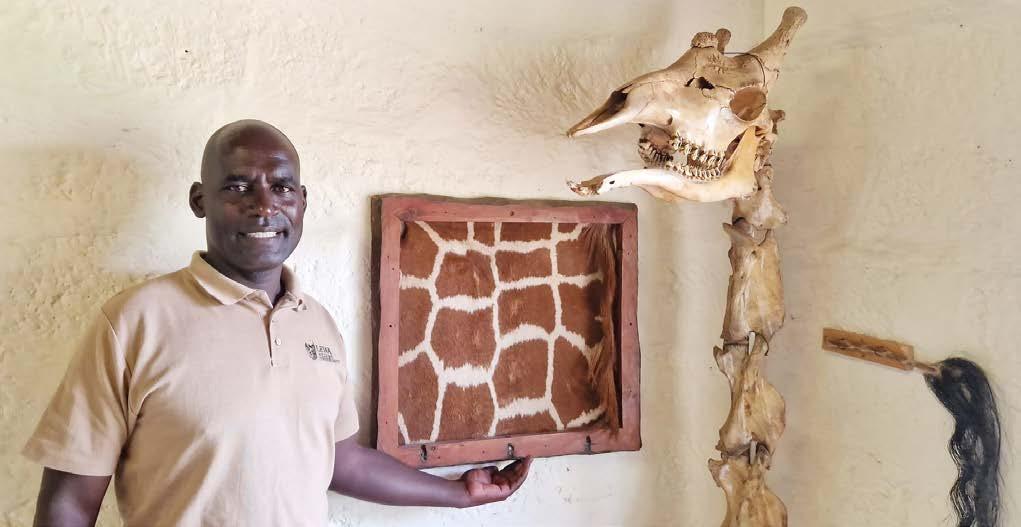
NDEGE NEWS | MARCH - MAY 2024 | 37 FEATURE
Walking the Serengeti in the Company of Kings
Not an ‘added-extra’ but an essential booking
By Hollie M'gog
“In the beginning we were surrounded by nature: It provided us with all our needs – you could see it, smell it, reach out and touch it.” Jonathan & Angela
Scott
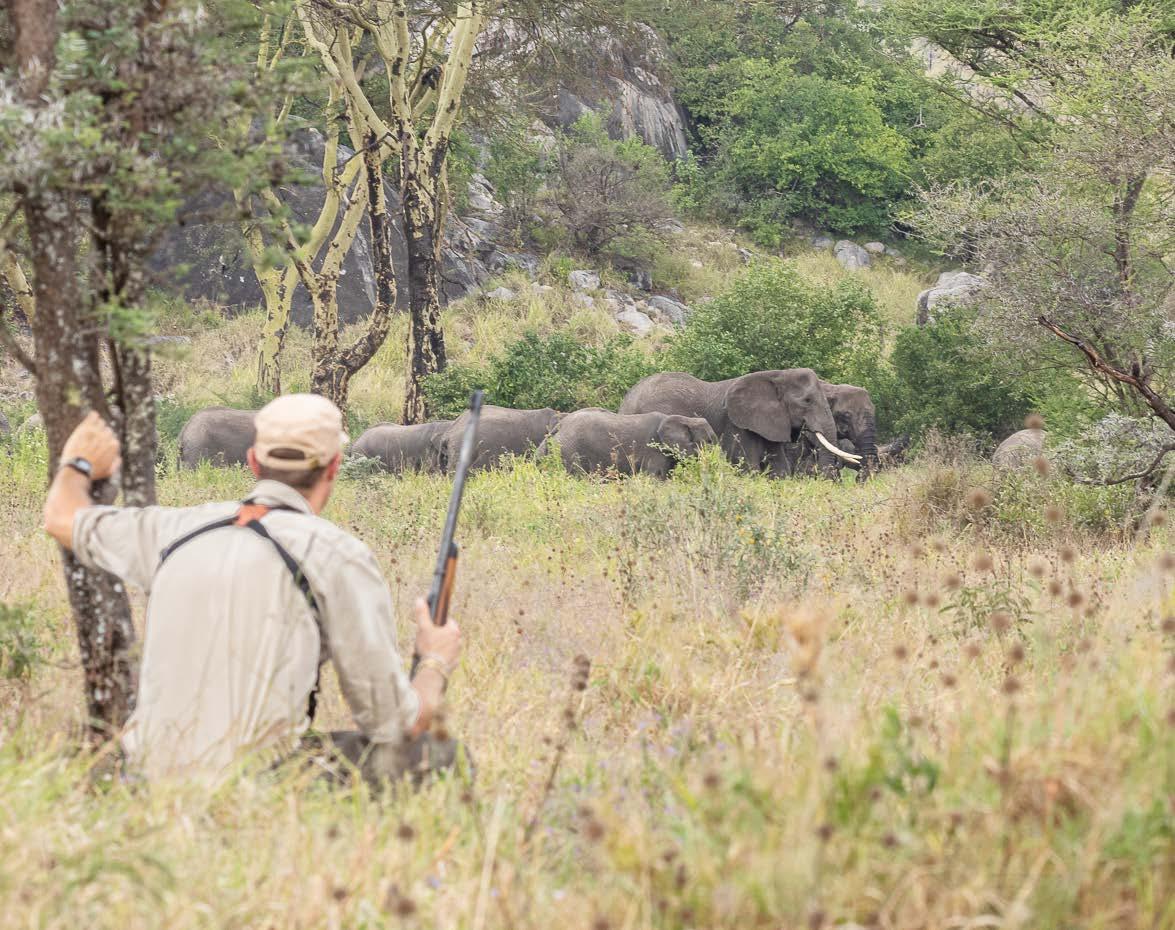
Two male lions, kings of the waving grasslands, peered out at us from amongst a clump of drop-seed grass, manes a-glitter with flecks of dew in the dawning sun. Their eyes lazily lifted to meet ours. A silent acknowledgment passed between us, a recognition of shared existence. As we continued our walk, quiet footsteps of a small group in the heart of the Serengeti, they flopped back down, uninterested in our human pursuits.
We ran our hands, as Andrea instructed, up and down the bark of the flat-topped Acacia (Vachellia tortilis), there was a knob worn smooth from the rubbing of folded, grey elephant bodies,
Lemala Walking. PHOTO: Rebecca A. Phillips
38 | NDEGE NEWS |DECEMBER 2023 - FEBRUARY 2024 FEATURE
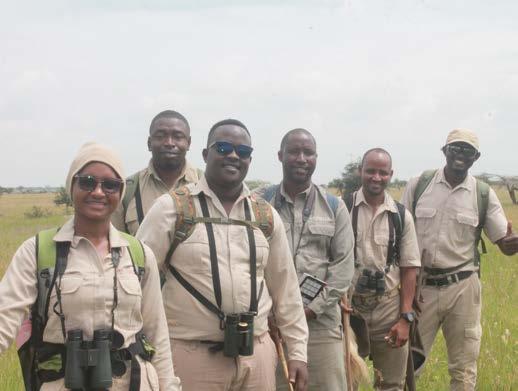
wiry-haired buffalo bottoms and the patterned flanks of those giants of the Serengeti – the Maasai Giraffe.
On foot you are no longer an observer from the safety of a vehicle, but a participant in the grand drama that is The Serengeti. In single file, behind a trained and incredibly knowledgeable Andrea Pompele, Lemala Guide Trainer & Head guide, who has elevated professionalism and immersive hosting to a platinum level, the rhythmic cadence of our steps echoed into the vast expanse of the Serengeti wilderness. No need for grand gestures; the wilderness demanded quiet respect and we gave it … willingly.
The Serengeti is zoned into high-use (where you have probably been, back-and-forth in your safari jeep, engine on, engine off, passing many another vehicle, keeping to bumpy roads and hearing never-ending radio chatter), low-use where Lemala conducts walking safaris from its Nanyukie and Kuria Hills Serengeti properties to no-use zones where the lions roar in solitude.
There is simply nothing that matches a walking safari (soon with fly-camps

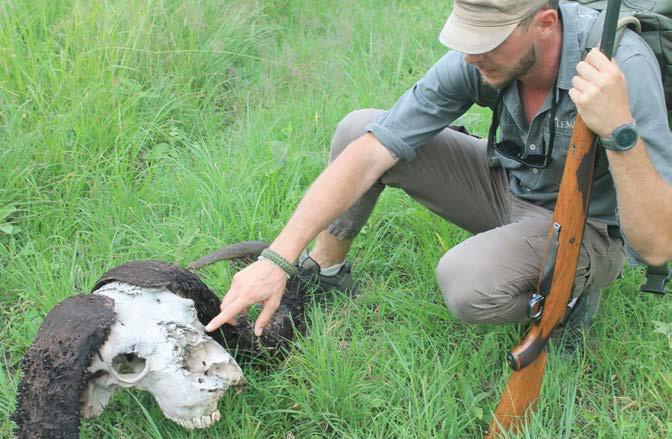
too) across the grasslands, where tracks in the dust tell stories in a language Andrea reads seamlessly –a stalking predator here, an ambling male elephant here, the passage of a herd of wildebeest. A female hippo moving out to graze, a mother warthog digging a home to protect her progeny.
Andrea speaks the language of wildflowers and pollinators too, of the birds and the stories they tweet into the warming morning – tales that are not interrupted with purring diesel engines and overtaking cars.
You read the geology underfoot, layers of time, a silent chronicle of the Serengeti's ancient past.
Hippo paths crossed our route –worn trails where these colossal creatures made their way to water, night after night, month after month. Walking along them, you cannot help but feel a connection to the pulse of the Serengeti.
We tried our hand at making fire from the Commiphora tree, rubbing a smooth stub between our palms, carefully blowing dry kindling, just
NDEGE NEWS | MARCH - MAY 2024 | 39
FEATURE
CLOCKWISE: Guide training, morning coffee on the walk, determining the reason of death
as the Maasai had for thousands of years (if I went back in time, I’d take a box of matches with me!) We tasted ripe berries, sharing the tree with chattering birds, we found a roosting bat who peered intently at us from beneath his folded wings, a Pearl-Spotted Owlet (yes, the bird that graces this magazine's front cover) was lured in by a flapping grasshopper and yet somehow it felt as if the silence of the savannah enveloped us. Here there were no trails worn smooth by frequent visitors, just the untouched landscape and the untamed beauty of the Serengeti. We were participants, not observers, in this raw and unfiltered encounter with the wild. We had become part of the canvas, threads in the intricate tapestry of the Serengeti.
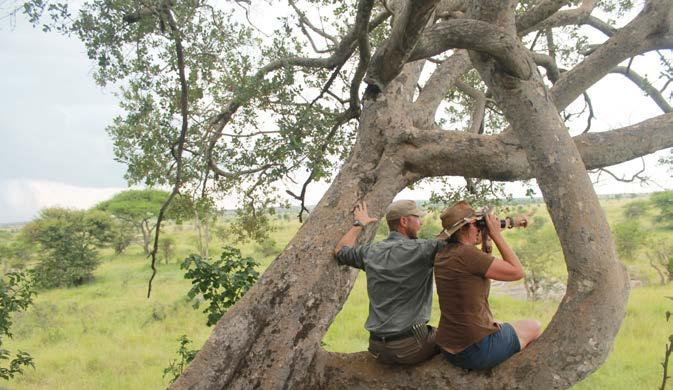
The sun had warmed considerably and before us grazed a small herd of impala, behind them a tower of giraffes ambled in the distance. A

How to get there
Lemala Walking is accessible by flights through Regional Air Services which offers daily scheduled flights to Northern Tanzania. It also offers charter services across Tanzania.
Additionally, Regional Air Services provide a daily scheduled connection from Northern Tanzania to Kenya’s Maasai Mara.
lone male elephant periscoped his trunk to catch our scent on the wind. Andrea talked us through each sighting, measured the risks and kept us at a safe distance at all times. The proximity, without the framed windows of a vehicle, brought a sense of immediacy. The rhythm of life played out before us – the prey and the predator, each acutely aware of the other's presence.
As you walk, your guide will carry a rifle, a silent assurance that in this realm, survival is a matter of respect and caution. A walking safari hurries nowhere, you just take it all in, one step at a time. It is an unfiltered communion with a wilderness that demands humility and leaves an indelible mark on those willing to walk its ancient but living paths.


40 | NDEGE NEWS |MARCH - MAY 2024
FEATURE
Sometimes it is worth just stopping to look at the view
Bush and Rock Hyrax can be found amongst the rock kopjes of the Serengeti

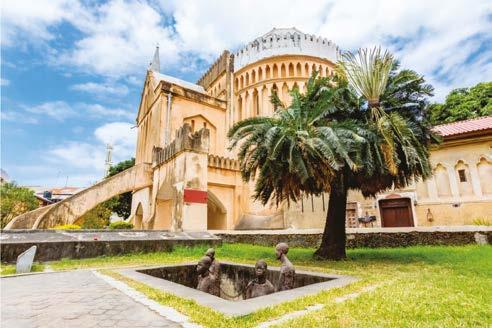
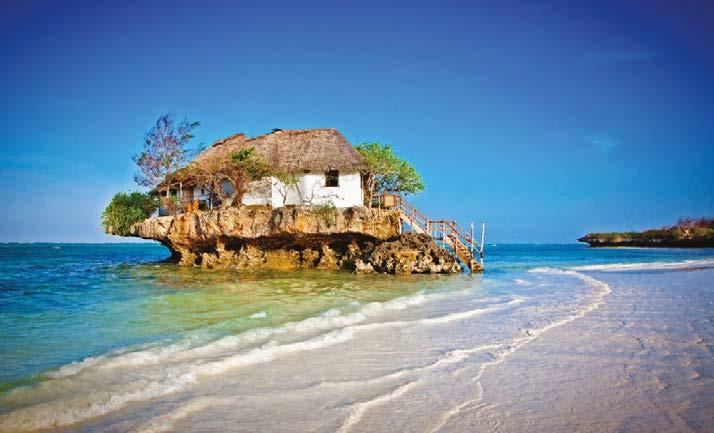
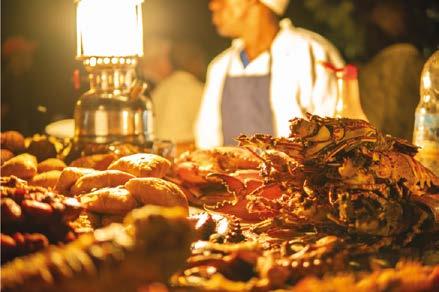
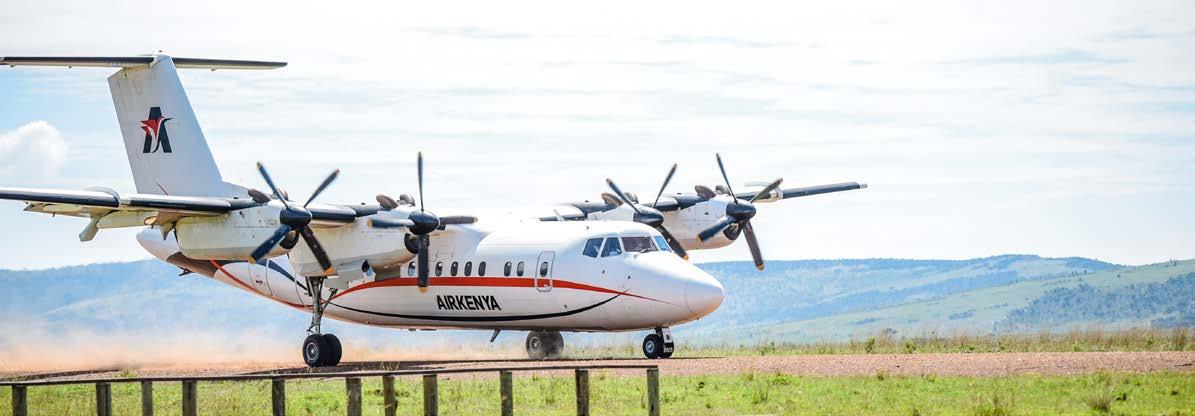
AIRKENYA FLIGHT SCHEDULE 2024
•
of 2 pax to operate.
• Flight from Amboseli to Wilson connects to Nanyuki, Lewa Downs, Samburu, Meru, and Loisaba at 10:00; Maasai Mara at 10:30 and Kilimanjaro at 13:30.
•
Service; minimum of 4 pax per sector to operate.
• Kilimanjaro service is non-operational between 16th March – 15th
and 1st
–
• This airport is your gateway to a safari between Kenya & Tanzania as it easily connects to Arusha, Manyara, Kogatende, Lobo with Regional Air Services at 15:30.
• Daily Service; minimum of 2 pax to operate.
• Special offer applies to flight departing Wilson at 07:30 and from Mara at 14:45.
• The inbound flight Masai Mara to Wilson arriving at 09:45 connects to our Wilson-Northern Kenya Services ie. Lewa, Loisaba, Meru, Nanyuki and Samburu at 10:00.
• Masai Mara services op erates into multiple airstrips, therefore timings may vary depending on aircraft routing.
• The arrival and departure times depict the first stop.
• Call Airkenya operations on departure date to confirm arrival and pick up times for various airstrips.
MERU
• Daily service; minimum of 2 pax to operate.
• Arrival and departure times to/from Lewa Downs may vary significantly by up to 45 minutes depending on aircraft routing over multiple airstrips.
• Flight from Lewa to Masai Mara may route via Wilson in low season to connect on the 14:00 flight.
• Flight from Lewa to Wilson connects to Kilimanjaro at 13:30 and to Masai Mara at 14:00.
• Flight from Masai Mara connects to Lewa via Wilson at 10:00.
• Call Airkenya operations on departure date to confirm arrival and pick up times for various airstrips. LOISABA
• Daily service; minimum of 2 pax to operate.
• Arrival and departure times to/from Meru may vary significantly by up to 45 minutes depending on aircraft routing over multiple airstrips.
• Flight from Meru to Masai Mara may route via Wilson in low season to connect on the 14:00 flight.
• Flight from Meru to Wilson connects to Kilimanjaro at 13:30 and to Masai Mara at 14:00.
• Flight from Meru to Samburu is a one-direction service.
• Flight from Masai Mara connects to Meru via Wilson at 10:00.
• Call Airkenya operations on departure date to confirm arrival and pick up times for various airstrips.
• Daily service; minimum of 2 pax to operate.
• Arrival and departure times to/from Loisaba may vary significantly by up to 45 minutes depending on aircraft routing over multiple airstrips.
• Flight from Loisaba to Masai Mara may route via Wilson in low season to connect on the 14:00 flight.
• Flight from Loisaba to Wilson connects to Kilimanjaro at 13:30 and to Masai Mara at 14:00.
• Flight from Masai Mara connects to Loisaba via Wilson at 10:00.
• Call Airkenya operations on departure date to confirm arrival and pick up times for various airstrips.
MASAI MARA
P2
• Daily Service; minimum of 2 pax to operate.
• The inbound flight Masai Mara to Wilson arriving at 09:45 connects to our Wilson-Northern Kenya Services i.e Lewa, Loisaba, Meru, Nanyuki and Samburu at 10:00.
• Masai Mara services operates into multiple airstrips, therefore timings may vary depending on aircraft routing.
• The arrival and departure times depict the first stop.
• Call Airkenya operations on departure date to confirm arrival and pick up times for various airstrips.
• Daily service to Nanyuiki Civil and Kamok airstrips; minimum of 2 pax to operate.
• Arrival and departure times to/from Nanyuki/Kamok may vary significantly by up to 45 minutes depending on aircraft routing over multiple airstrips.
• Flight from Nanyuki Civil/Kamok to Masai Mara may route via Wilson in low season to connect on the 14:00 flight.
• Flight from Nanyuki Civil/Kamok to Wilson connects to Kilimanjaro at 13:30 and to Masai Mara at 14:00.
• Flight from Masai Mara connects to Nanyuki Civil/Kamok via Wilson at 10:00.
• Call Airkenya operations on departure date to confirm arrival and pick up times for various airstrips.
AMBOSELI FLT NO FROM TO DEPART ARRIVE P2 883 WILSON AMBOSELI 07:30 08:05 P2 884 AMBOSELI WILSON 08:15 08:50
Daily service; minimum
FLT NO FROM TO DEPART ARRIVE P2 821 WILSON KILIMANJARO 13:30 14:25 P2 822 KILIMANJARO WILSON 14:40 15:35
KILIMANJARO
Daily
Nov
20th Dec.
May
DOWNS FLT NO FROM TO DEPART ARRIVE P2 861 WILSON LEWA DOWNS 09:00 10:00 P2 871 WILSON LEWA DOWNS 10:00 11:00 P2 872 LEWA DOWNS WILSON 11:15 13:25 P2 862 LEWA DOWNS MASAI MARA 10:15 12:15
LEWA
FLT NO FROM TO DEPART ARRIVE P2 861 WILSON LOISABA 09:00 10:00 P2 871 WILSON LOISABA 10:00 11:00 P2 872 LOISABA WILSON 11:15 13:25 P2 862 LOISABA MASAI MARA 10:15 12:15
FLT NO FROM TO DEPART ARRIVE P2 851 WILSON MASAI MARA 07:30 08:10 P2 852 MASAI MARA WILSON 08:15 09:45 P2 853 WILSON MASAI MARA 10:30 11:10 P2 854 MASAI MARA WILSON 11:15 13:00 P2 951 WILSON MASAI MARA 14:00 14:40
952 MASAI MARA WILSON 14:45 16:15
MASAI MARA *SPECIAL* FLT NO FROM TO DEPART ARRIVE P2 851 WILSON MASA MARA 07:30 08:10 P2 952 MASAI MARA WILSON 14:45 16:15
FLT NO FROM TO DEPART ARRIVE P2 861 WILSON MERU 09:00 10:00 P2 871 WILSON MERU 10:00 11:00 P2 872 MERU WILSON 11:15 13:25 P2 861 MERU NANYUKI 10:15 11:00 P2 861 MERU SAMBURU 10:15 10:30 P2 862 MERU MASAI MARA 10:15 12:15
NANYUKI / KAMOK FLT NO FROM TO DEPART ARRIVE P2 861 WILSON NANYUKI 09:00 10:00 P2 871 WILSON NANYUKI 10:00 11:00 P2 872 NANYUKI WILSON 12:30 13:25 P2 871 NANYUKI MERU 11:15 12:00 P2 862 NANYUKI MASAI MARA 10:15 12:15
AIRKENYA FLIGHT SCHEDULE 2024
SAMBURU
• Daily service to Samburu Kalama; minimum of 2 pax to operate.
• Arrival and departure times to/from Samburu may vary significantly by up to 45 minutes depending on aircraft routing over multiple airstripes.
• Flight from Samburu Kalama to Masai Mara may route via Wilson in low season to connect on the 14:00 flight.
• Flight from Samburu Kalama to Wilson connects to Kilimanjaro at 13:30 and to Masai Mara at 14:00.
• You can now connect to Samburu Kalama from Masai Mara via Wilson on the morning flight at 10:00.
• Call Airkenya operations on departure date to confirm arrival and pick up times for various airstrips.
MIGORI / TARIME
• Daily Service; minimum of 2 pax to operate except 1st April - 31st
requires minimum 4 pax.
• Service operates into multiple airstrips therefore timings may vary depending on aircraft routing.
• The service connects AirKenya Masai Mara services with Regional Air /Auric Air/ Coastal Aviation Serengeti services.
MASAI MARA - SERENGETI VV (VIA MIGORI/TARIME)
•
• Flight services route via Migori and Tarime.
• AirKenya provides road transfer and handling between Migori and Tarime.
• Service operates into multiple airstrips therefore pick up and drop off timings may vary depending on aircraft routing.
• The service connects AirKenya Masai Mara services with Regional Air /Auric Air/ Coastal Aviation Serengeti services.
P2/ A8* 551/ 131 MASAI MARA KIDEPO (KVNP) 08:15 14:45
• This Service operates between 01st-June- 30th September.
• Mara - Entebbe - Mara Service requires a minimum of 4 pax per sector to operate.
• Entebbe - Kasese Service will require a minimum of 2 pax while Entebbe-Mweya service requires a minimum of 4 pax to operate.
• Entebbe - Kidepo Service will require a minimum of 7 pax and will operate on Wed, Fri and Sun.
• During the period that Bugungu airstrip is closed, we are using Pakuba as the designated alternative airstrip.
• Flight services route via Kisumu and Entebbe Airports for Customs and Immigration.
• Service operates into multiple airstrips therefore pick up and drop off timings may vary depending on aircraft routing.
• Maasai Mara-Entebbe flight service connects the same day to all AeroLink Airstrips except Kisoro which strictly operates in the morning. Early morning flight Kisoro-Entebbe flight service, however, connects the same day into the Masai Mara.
HIGH SEASON: 21 DEC 2023 - 28 FEB 2024; 01 JUN 2024 - 31 OCT 2024
LOW SEASON: 01 MAR 2024 - 31 MAY 2024; 01 NOV 2024 - 20 DEC 2024
Valid from 21st December 2023 to 20th December 2024
• CHECK IN TIME is 60 minutes to departure time in Nairobi (Wilson), Kilimanjaro, Kisumu and Entebbe Airports. Passengers will not be allowed to check in 30 minutes to departure time on the mentioned airstrips.
• Check in time for all bush airstrips is 30 minutes before flight departure time.
• Contact Airkenya Operations department on the morning of the scheduled flight to get approximate arrival and departure times for various bush airstrips.
• Airkenya guarantees all its connecting flights within Kenya and across East Africa in conjunction with its subsidiaries; Regional Air Services and Aerolink Uganda.
• Contact the Charter department for tailor-made services or if the scheduled service does not meet your requirements: charters@airkenya.com
• AirKenya reserves the right to change departure times or carrier when so required for operational, weather or safety reasons.
Email resvns@airkenya.com or call +254 (0)20 391 6000 for further clarification.
NDEGE NEWS | MARCH - MAY 2024 | 43
FLT NO FROM TO DEPART ARRIVE P2 861 WILSON SAMBURU 09:00 10:00 P2 871 WILSON SAMBURU 10:00 11:00 P2 872 SAMBURU WILSON 11:15 13:25 P2 862 SAMBURU MASAI MARA 10:15 12:15
FLT NO FROM TO DEPART ARRIVE P2 453 MASAI MARA MIGORI 08:15 09:00 P2 453 MASAI MARA TARIME 08:15 10:10 P2 454 TARIME MASAI MARA 10:30 12:40 P2 454 MIGORI MASAI MARA 11:30 12:40
Dec
May & 1st Nov - 20th
FLT NO FROM TO DEPART ARRIVE P2/N8 453/422 MASAI MARA SERONERA 08:15 11:20 N8/P2 421/454 SERONERA MASAI MARA 09:15 12:40 P2/N8 453/422 MASAI MARA KOGATENDE 08:15 11:20 N8/P2 421/454 KOGATENDE MASAI MARA 09:15 12:40 P2/N8 453/432 MASAI MARA MANYARA 08:15 12:00 N8/P2 431/454 MANYARA MASAI MARA 08:40 12:40 P2/N8 453/422 MASAI MARA FORT IKOMA 08:15 11:20 N8/P2 421/454 FORT IKOMA MASAI MARA 09:15 12:40 P2/N8 453/422 MASAI MARA NDUTU 08:15 11:45 N8/P2 115/454 NDUTU MASAI MARA 08:00 12:40 P2/N8 453/422 MASAI MARA LOBO 08:15 11:20 N8/P2 421/454 LOBO MASAI MARA 09:15 12:40 P2/N8 453/422 MASAI MARA SERENGETI SOUTH 08:15 11:20 N8/P2 421/454 SERENGETI SOUTH MASAI MARA 09:15 12:40 P2/N8 453/422 MASAI MARA SASAKWA 08:15 11:20 N8/P2 421/454 SASAKWA MASAI MARA 09:15 12:40 P2/N8 453/422 MASAI MARA GRUMETI 08:15 11:20 N8/P2 421/454 GRUMETI MASAI MARA 09:15 12:40
Daily Service; minimum of 2 pax to operate except 1st April - 31st May & 1st Nov - 20th Dec requires minimum 4 pax.
MASAI MARA - UGANDA VV (VIA KISUMU/ENTEBBE) FLT NO FROM TO DEPART ARRIVE P2 551 MASAI MARA KISUMU 08:15 09:20 P2 552 KISUMU MASAI MARA 13:25 14:30 P2 551 MASAI MARA ENTEBBE 08:15 11:00 P2 552 ENTEBBE MASAI MARA 11:45 14:30 P2 551 KISUMU ENTEBBE 10:00 11:00 P2 552 ENTEBBE KISUMU 11:45 12:45 P2/A8* 551/121 MASAI MARA KIHIHI (BINP) 08:15 14:40 A8*/P2 112/552 KIHIHI MASAI MARA 09:45 14:30 P2/A8* 551/ 121 MASAI MARA KASESE/MWEYA (QENP) 08:15 14:15 A8*/P2 112/552 KASESE/MWEYA MASAI MARA 10:20 14:30 P2/A8* 551/131 MASAI MARA BUGUNGU 08:15 13:00 P2/A8* 551/131 MASAI MARA PAKUBA/CHOBE (MFNP) 08:15 13:00 P2/ A8* 551/ 131 MASAI MARA KIDEPO (KVNP) 08:15 14:45 P2/A8* 551/131 MASAI MARA PAKUBA/CHOBE (MFNP) 08:15 13:00
QENP
Elizabeth National Park.
Murchison
National Park. KVNP - Kidepo Valley National Park.
BINP - Bwindi Impenetrable National Park.
- Queen
MFNP -
Falls
Call Centre - +254 (0)20 391 6000 / +254 (0) 20 3925000 Operations: +254 (0) 706 085534 / +254 (0) 727 131977 Email: resvns@airkenya.com / marketing@airkenya.com Website: www.airkenya.com Contact the Charter department for tailor-made services or if the scheduled service does
meet your requirements:
not
charters@airkenya.com
AIRKENYA AIRCRAFT FLEET
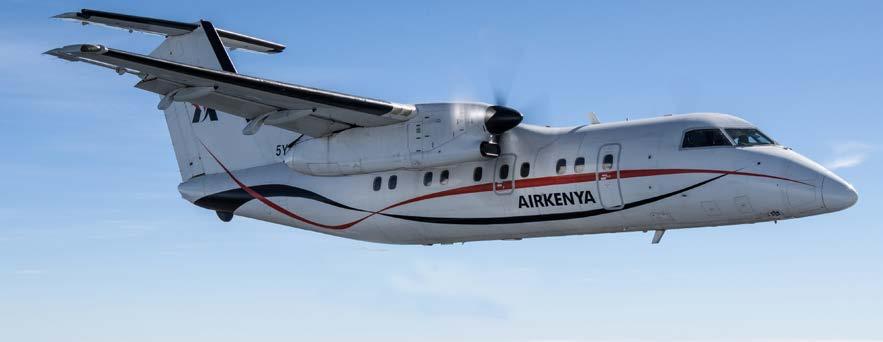
BOMBARDIER DHC 8-202 (DASH 8)
Manufacturer: Bombardier
Crew: 5 (2 pilots, 1 flight attendant, 1 engineer, 1 Baggage Master)
Passengers: Maximum 37
Description: Pressurised aircraft ideal for both African bush and city flying
No in Fleet: 2

DHC 7-100 (DASH 7)
Manufacturer: Dehavilland Canada
Crew: 5 (2 Pilots, 2 Flight attendants, 1 Engineer and 1 Baggage Master)
Passengers: Maximum 49
Description: Pressurised STOL (short take-off and landing) aircraft ideal for African bush flying
No in Fleet: 2
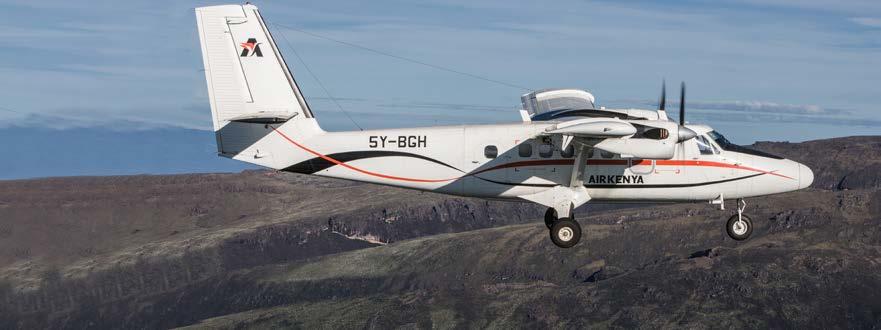
DHC 6-300 (TWIN OTTER)
Manufacturer: Dehavilland Canada
Crew: 2 pilots
Passengers: Maximum 18
Description: STOL (short take-off & landing) aircraft with fixed landing gear ideal for African bush flying
No in Fleet: 3
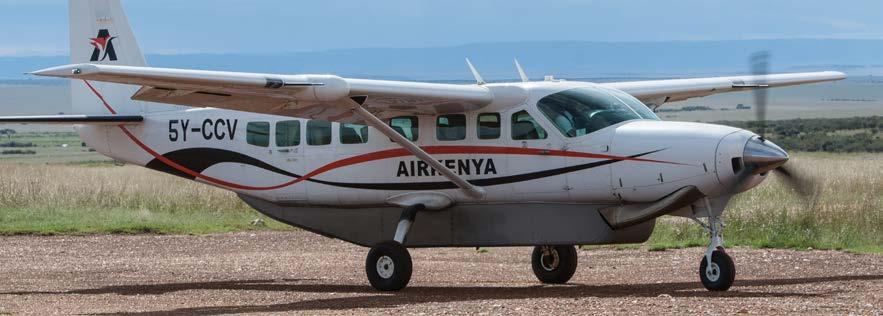
CESSNA GRAND CARAVAN C208B
Manufacturer: Cessna Aircraft Company
Crew: 2 pilots
Passengers: Maximum 11
Description: STOL Aircraft with fixed undercarriage ideal for African bush flying
No in Fleet: 2
- Kihihi and Kisoro airstrips
2. Queen Elizabeth National Park
- Kasese and Mweya airstrips
3. Kibale Forest National Park
- Kasese airstrip
4. Murchison Falls National Park
- Pakuba and Chobe airstrips
5. Kidepo National Park - Apoka Airstrip
6. Entebbe - Maasai Mara Via Kisumu
KISUMU MALINDI
DIANI LAMU
1. Amboseli
2. Kilimanjaro
3. Lewa Downs
4. Masai Mara
5. Meru
6. Nairobi
7. Nanyuki
8. Samburu
9. Migori
10. Loisaba
11. Kisumu
12. Entebbe
1. Bwindi Impenetrable Forest
1. Arusha
2. Kilimanjaro
3. Kogatende
4. Lake Manyara
5. Lobo
6. Ndutu
7. Seronera
8. Zanzibar
9. Tarime
LAKE MBURO NAT. PARK
KIBALE NAT. PARK
JINJA
MBARARA
APOKA KIDEPO
Lobo AM
REGIONAL AIR SERVICES

Manyara AM Arusha 11:50 12:15
Arusha 13:05 13:35 Operated only July & August
Kilimanjaro 11:50 13:15
Kilimanjaro 13:05 13:45 Operated only July & August
Kogatende 8:40 9:25
Kogatende 10:30 11:10 Operated only July & August
Lobo 8:40 10:20
Ndutu *** 8:40 9:05
Seronera 8:40 10:30
Seronera 10:30 11:50 Operated only July & August
Zanzibar 11:50 14:35
Zanzibar 13:05 15:35 Operated only July & August
Ndutu AM Arusha *** 11:35 12:15
Kilimanjaro *** 11:35 13:10
Kogatende *** 9:20 10:00
Lobo *** 9:20 9:50
Manyara *** 11:35 12:00
Seronera *** 9:20 10:30
Tarime *** 9:15 10:15
Masai Mara*** 9:15 12:40 Connects with Airkenya at Migori
Zanzibar *** 11:35 14:35
Masai Mara Kogatende 8:15 TBA Connects with Regional Air at Tarime
Lobo 8:15 TBA Connects with Regional Air at Tarime
Ndutu*** 8:15 TBA Connects with Regional Air at Tarime
Seronera 8:15 TBA Connects with Regional Air at Tarime
Kilimanjaro PM
Zanzibar 12:20 15:35
Tarime
Masai
Arusha
Kilimanjaro 9:45 13:10
Kilimanjaro 9:45 13:45
Kogatende 9:45 9:55
Manyara 9:45 11:35
Ndutu *** 9:45 10:15
Seronera 9:45 10:30
Zanzibar 9:45 14:35
Zanzibar 9:45 15:35
Tarime 9:15 10:15
Masai Mara 9:15 12:40
Only July & August
only July & August
NOTES
• All timings are estimates and will vary depending on aircraft routing more
• *ON REQUEST means we will only operate where there is sufficient traffic to justify the operation and timing or when extra cost is covered
• **ON INDUCEMENT means flights which we will operate at scheduled rates for 4 passengers or more
• ***SEASONAL is June to October and
• ****TBA means time to be advised depending on
that day
only July & August
• A minimum of 2 pax is required for RAS to operate into any airstrip that’s not
or request.
December
March
to
flight plan
on inducement
SCHEDULE VALID FROM 1ST JANUARY 2024 UPTO 31ST DECEMBER 2024
SCHEDULE 2024 FROM TO ETD ETA COMMENTS Arusha AM Kogatende 8:00 9:55 Lobo 8:00 9:25 Manyara 8:00 8:25 Manyara 9:50 10:10 Operated only July & August Ndutu *** 8:00 9:05 Seronera 8:00 10:30 Kogatende 7:00 7:45 operated only July & August Kogatende 9:50 11:10 Operated Only July & August seronera 7:00 8:25 Operated Only July & August Seronera 9:50 11:50 Operated Only July & August Arusha PM Kilimanjaro 13:00 13:15 Manyara 16:00 16:25 Seronera 13.00 17:15 Kilimanjaro 13.15 13:30 Operated Only July & August Arusha Zanzibar 13:00 14:35 Zanzibar 14:30 15:35 Operated Only July & August Zanzibar Arusha 15:00 16:35 Arusha 16:00 17:05 Operated Only July & August Kilimanjaro PM Arusha 15:30 15:45 Manyara 15:30 16:25 Seronera 15:30 17:15 Kogatende AM Arusha 10:00 12:15 Arusha 8:05 9:25 Operated only July & August Arusha 11:30 13:35 Operated only July & August Kilimanjaro 10:00 13:10 Kilimanjaro 11:30 13:45 Operated only July & August Lobo 10:00 TBA Manyara 10:00 11.35 Manyara 11:30 12:55 Operated only July & August Ndutu *** 10:00 TBA Seronera 10:00 10:30 Seronera 8:05 8:25 Operated only July & August Zanzibar 10:00 14:35 Zanzibar 11:30 15:35 Operated only July & August Tarime 9:15 10:15 Masai Mara 9:15 12:40 Connects with Airkenya at Migori Seronera AM Arusha 11:00 12:15 Arusha 8:45 9:25 Operated only July & August Arusha 12:20 13:35 Operated Only July & August Kilimanjaro 11:00 13:10 Kilimanjaro 12:20 13:45 Operated only July & August Lobo 9:30 9:50 Manyara 11:00 11:35 Manyara 12:20 12:55 Operated only July & August Zanzibar 11:00 14:35
FLIGHT
Operated
9:15 10:15
Mara 9:15 12:40 Connects with Airkenya at Migori
Arusha
12:15
9:45
9:45 13:35 Operated
July
Only
& August
Operated
Operated
Connects
with Airkenya at Migori
Ndutu*** 15:30 17:15 Arusha PM Ndutu *** 16:00 17:15 Arusha Nairobi, Wilson 13:00 15:20 Kilimanjaro 14:25 15:20 Lobo 9:45 15:20 Kogatende 10:00 15:20 Manyara 11:50 15:20 Ndutu*** 11:35 15:20 Seronera 11:00 15:20 Kilimanjaro - Wilson Sector Operated by AirKenya Express Nairobi, Wilson Arusha 13:15 15:45 Kilimanjaro 13:15 14:10 Manyara 13:15 16:25 Seronera 13:15 17:05 Wilson - Kilimanjaro Sector Operated by Airkenya Express FROM TO ETD ETA COMMENTS YEARS 1997-2022 2 Reservations: +255 754 285 754 resvns@regional.co.tz www.regionaltanzania.com Operations: +255 753 500 300 ops@regional.co.tz Charters: +255 675 285 753 charters@regional.co.tz Sales/Marketing Depatment: +255 783 718 441
REGIONAL AIR FLEET
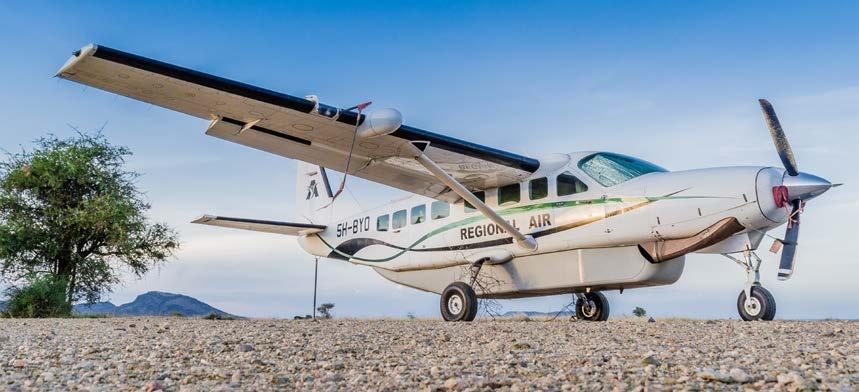
CESSNA GRAND CARAVAN C208B
Manufacturer: Cessna Aircraft Company, USA
Crew: 2 pilots
Passengers: Maximum 12
Description: STOL Aircraft with fixed undercarriage ideal for African bush flying
Fleet No.: 2
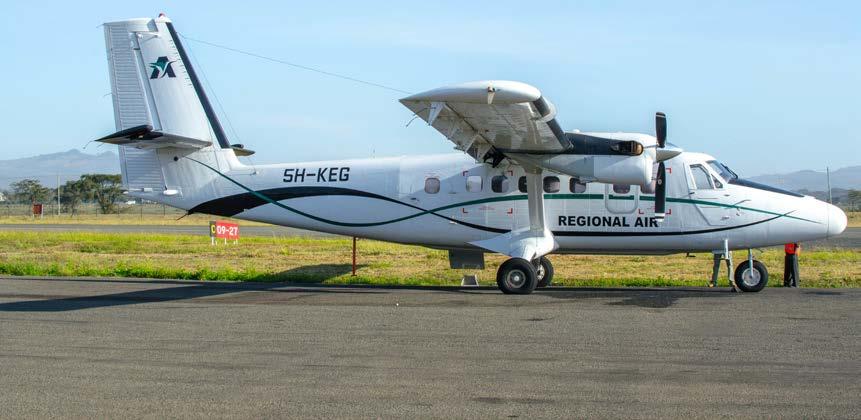
DHC 6-300 (TWIN OTTER)
Manufacturer: Dehavilland, Canada
Crew: 2 pilots
Passengers: Maximum 18
Description: STOL (short take-off & landing) aircraft with fixed landing gear ideal for African bush flying No in Fleet: 1

BOMBARDIER DHC 8-202 (DASH 8)
Manufacturer: Bombardier
Crew: 4 (2 pilots, 1 flight attendant and 1 engineer)
Passengers: Maximum 37
Description: Pressurized cummuter aircraft
Fleet No.: 1

BWINDI
(SOUTH)
LAKE MBURO NATIONAL PARK
•
•
•
•
•
•
KIBALE FOREST NATIONAL PARK AND QUEEN ELIZABETH NATIONAL PARK
QUEEN
Mweya
• CHECK IN TIME is 60 minutes to departure time in Entebbe International Airport.
• Check in time for all bush airstrips is 30 minutes before flight departure time.
• Contact AeroLink Operations department on the morning of the scheduled flight to get approximate arrival and departure times for various bush airstrips.
• AeroLink guarantees all its connecting flights within Uganda and across East africa in conjunction with Airkenya Express.
• Flight to/from Jinja to Kisoro/Kihihi/Kasese/Mweya/ Murchison Falls on request at a surcharge of USD 1000
• AeroLink reserves the right to change departure times or carrier when so required for operational, weather or safety reasons.
• Contact the Charter department for tailor-made services or if the scheduled service does not meet your requirements: info@aerolinkuganda.com
48 | NDEGE NEWS |MARCH - MAY 2024
IMPENETRABLE
DAILY SERVICE FLT NO FROM TO DEPART ARRIVE A8* 111 ENTEBBE KISORO 0700 0815 A8* 112 KISORO ENTEBBE 0830 1125 A8* 117 ENTEBBE KISORO 1015 1130 A8* 118 KISORO ENTEBBE 1145 1400 • Timings may vary depending on aircraft routing. Kisoro flights are subject to the prevailing weather conditions and strictly morning flights. • Kisoro has a surcharge of USD 70 per person. • From Kisoro airstrip passengers can connect to:- Kihihi, Mweya and Kasese airstrips on request at seat rate. • Flight 112 from Kisoro, passengers can connect to Masai Mara Via Entebbe and Kisumu for Immigration. • Flight 117/118 will operate for the months of JUNE, JULY, AUGUST, SEPT AND OCT and may delay due to prevailing weather conditions.
IMPENETRABLE FOREST NATIONAL PARK (NORTH) DAILY SERVICE FLT NO FROM TO DEPART ARRIVE A8* 111 ENTEBBE KIHIHI 0700 0845 A8* 112 KIHIHI ENTEBBE 0945 1125 A8* 117 ENTEBBE KIHIHI 1015 1155 A8* 118 KIHIHI ENTEBBE 1215 1400 A8* 121 ENTEBBE KIHIHI 1300 1530 A8* 122 KIHIHI ENTEBBE 1545 1715 • Timings may vary depending on aircraft routing. • Flight 112 from Kihihi passengers can connect onwards to Masai Mara Via Entebbe and Kisumu for Immigration • Flight 117/118 operate daily except April, May and November
Flight 121 may route via Murchison Falls National Park subject to loads
From Kihihi Airstrip passengers can connect to: - Kisoro, Mweya, Kasese and Mbarara airstrips on request at seat rate.
FOREST NATIONAL PARK
BWINDI
•
•
DAILY SERVICE FLT NO FROM TO DEPART ARRIVE A8* 111 ENTEBBE KASESE 0700 1000 A8* 112 KASESE ENTEBBE 1015 1125 A8* 117 ENTEBBE KASESE 1015 1205 A8* 118 KASESE ENTEBBE 1220 1400 A8* 121 ENTEBBE KASESE 1300 1530 A8* 122 KASESE ENTEBBE 1545 1715 • Timings may vary depending on aircraft routing. • Minimum of 2 passengers to operate • Flight 112 from Kasese/Mweya passengers can connect onwards to Masai Mara Via Entebbe and Kisumu for Immigration • Flight 117/118 operate daily except April, May and November • Flight 121 may route via Murchison Falls National Park subject to loads. From Kasese Airstrip passengers can connect to: - Mweya, Kihihi, Kisoro and Mbarara airstrips on request at seat rate.
DAILY SERVICE FLT NO FROM TO DEPART ARRIVE A8* 111 ENTEBBE MWEYA 0700 1005 A8* 112 MWEYA ENTEBBE 1020 1125 A8* 117 ENTEBBE MWEYA 1015 1205 A8* 118 MWEYA ENTEBBE 1220 1400 A8* 121 ENTEBBE MWEYA 1300 1530 A8* 122 MWEYA ENTEBBE 1545 1715
ELIZABETH NATIONAL PARK
Timings may vary depending on aircraft routing.
Minimum of 4 passengers to operate
Flight
Kasese/Mweya passengers can connect onwards
for Immigration Flight 117/118 operate daily except April, May and November
112 from
to Masai Mara Via Entebbe and Kisumu
Flight 121 may route via Murchison Falls National Park subject to loads.
seat rate. Notes
From
Airstrip passengers can connect to: - Kasese, Kihihi, Kisoro and Mbarara airstrips on request at
DAILY SERVICE FLT NO FROM TO DEPART ARRIVE A8* 117 ENTEBBE MBARARA 1015 1100 A8* 118 MBARARA ENTEBBE 1245 1400 • Timings may vary depending on aircraft routing. • Minimum of 4 passengers to operate
Flight 117/118 operate daily except April, May and November
•
From Mbarara airstrip, passengers can connect to:-
Kihihi Mweya
Kasese airstrips on request at seat rate MURCHISON FALLS NATIONAL PARK (PAKUBA, CHOBE AIRSTRIPS) DAILY SERVICE FLT NO FROM TO DEPART ARRIVE A8* 121 ENTEBBE MURCHISON 1300 1400 A8* 122 MURCHISON ENTEBBE 1415 1715 • Timings may vary depending on aircraft routing. • Minimum of 4 passengers to operate • From Murchison, passengers can connect to:- Kasese, Mweya and Kihihi airstrips MURCHISON FALLS NATIONAL PARK - QENP & BINP DAILY SERVICE FLT NO FROM TO DEPART ARRIVE A8* 121 PAKUBA/ CHOBE KASESE/MWEYA/ KIHIHI 1415 1530 • Timings may vary depending on aircraft routing. • Minimum of 4 passengers to operate QENP - Queen Elizabeth National Park (Kasese and Mweya airstrips) BINP - Bwindi Impenetrable Forest National Park (Kihihi airstrip) KIDEPO VALLEY NATIONAL PARK WEDNESDAY, FRIDAY AND SUNDAY FLT NO FROM TO DEPART ARRIVE A8* 131 ENTEBBE KIDEPO 1300 1430 A8* 132 KIDEPO ENTEBBE 1500 1630 • Timings may vary depending on aircraft routing. • Minimum of 7 passengers to operate MASAI MARA - ENTEBBE SEASONAL SERVICE - JUNE - SEPTEMBER FLT NO FROM TO DEPART ARRIVE P2 551 MASAI MARA ENTEBBE 0815 1100 P2 552 ENTEBBE MASAI MARA 1145 1430 P2 551 MASAI MARA *KISUMU 0815 0920 P2 552 *KISUMU MASAI MARA 1325 1430 P2 551 *KISUMU ENTEBBE 1000 1100 P2 552 ENTEBBE *KISUMU 1145 1245 • Timings may vary depending on aircraft routing. • *Routes Via Kisumu for Immigration • Minimum of 4 passengers to operate • From Masai Mara, passengers can connect to: Kihihi, Kasese, Mweya, Pakuba, Chobe and Kidepo. FLIGHT SCHEDULE Valid: January to December 2024 +256 31 733 3000 +256 776 882203 info@aerolinkuganda.com aerolinkuganda @aerolinkuganda @aerolinkuganda in aerolinkuganda www.aerolinkuganda.com
Kisoro,
and
AEROLINK AIRCRAFT FLEET
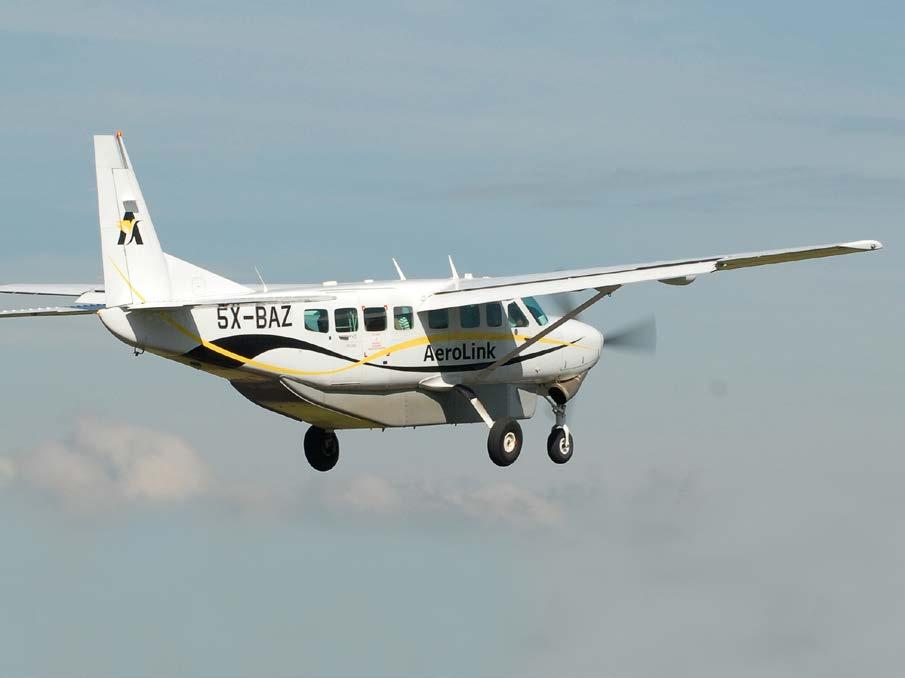
CESSNA GRAND CARAVAN C208B
Manufacturer: Cessna Aircraft Company, USA
Crew: 2 pilots
Passengers: Maximum 11
Description: STOL Aircraft with fixed undercarriage ideal for African bush flying
No in Fleet: 3

NAIROBI
Airkenya Express Limited, Wilson Airport
P.O. Box 30357 - 00100 Nairobi, Kenya
Telephone numbers:
Call Centre (Reservations) +254 (0)20 391 6000
Administration:
(Operations, Sales Marketing & Accounts)
+254 (0) 20 3925000, 6005745/6, +254 (0) 206005730
Mobile: +254 (0) 721 415346, 0733 731865, +254 (0) 727 131977
E-mail: resvns@airkenya.com, operations@airkenya.com charters@airkenya.com & helicopters@airkenya.com ENTEBBE
www.airkenya.com
www.regionaltanzania.com
P.O.
RESERVATIONS
Tel:
OPERATIONS
Tel:
ADMINISTRATION
Tel: +256 31 733000
Email: info@aerolinkuganda.com
www.aerolinkuganda.com


AIRPORT - UGANDA
INTERNATIONA
BOX
Entebbe
689
+256
31 7333000
+256 776 8882205
@AirKenyaExpress AEROLINK Airkenya Express @airkenya_official


+256 31 733 3000 /+256 776 882205 For more information: @aerolinkuganda aerolinkuganda in www.aerolinkuganda.com info@aerolinkuganda.com +256 776 882203 www.airkenya.com www.aerolinkuganda.com www.regionaltanzania.com

Accessing KCAA services is simple on the e-citizen portal. Visit: ecitizen.kcaa.or.ke


































 Editor, Ndege News
Editor, Ndege News








































































 Guided walking safari in Mara Naboisho Conservancy
CLOCKWISE: Sunset from the verandah at Saruni Mara ; Saruni Rhino Swimming Pool
Guided walking safari in Mara Naboisho Conservancy
CLOCKWISE: Sunset from the verandah at Saruni Mara ; Saruni Rhino Swimming Pool

























































